It's interesting that the Egyptians thought that males made babies and that the woman needed to be a man to be reborn. To me, now, that's absurd but how did they rationalize it?
It's quite interesting. Before they had knowledge of how human reproduction really works, many ancient cultures thought that men, in their sperm, actually contained the future baby, kind of like a seed contains in itself the future plant. A woman's role in the process is just to "hold" that seed in her womb until the baby grows. Does that make any sense?
Oh ok, yes it does.
I'm in A Woman's Afterlife and I'm curious as to how archeologists and other scholars know when masculine forms were attached to deceased women to "transform" their gender in the afterlife? How did feminist scholarship come to this conclusion? Versus it being a mistake or some other cultural phenomena.
Some scholars did previously think that the masculine language and colors on women's funerary equipment was a mistake. But more recent feminist ideas and a more fluid understanding of gender has inspired scholars to approach the question from a different perspective.
Okay, so, it is hypothesized and unable to be corroborated? I was curious as to how they could confirm such facts.
That's true. The ancient Egyptians are not still around to ask, so no one can be 100% sure how they thought. However, this new interpretation does make a lot more sense. Scholars have concluded based on an extensive body of visual and textual evidence that women were painted yellow and men were painted red as well as the gendering of pronouns. We have also seen that the ancient Egyptians were a meticulous people and it seems unlikely that the same mistake would appear over and over again without meaning.
I agree. I was just curious as to when the moment occurred when scholars felt confident enough to make these interpretations, but I also agree that these mistakes are unlikely, especially if there was a significant volume of cases such as these.
This exhibition reflects very recent interpretations. The curator of A Woman's Afterlife bases a significant portion of the interpretation on the work of Egyptologist Kathlyn M. Cooney and an article she published in 2010.
I don't think it's necessarily a matter of confidence. It's more a matter of interest and social movements. Recently, there has been a trend of investigating the way that ancient people thought of themselves. This, coupled with our current wave of more pervasive feminism, has led to the approach seen in the gallery.
Thank you for the info. It's very interesting and I find it very intriguing how we struggle to not impart our own cultural ideologies on ancient cultures. I'm glad exhibits like these are challenging these perspectives.
Me too! Remembering to remove your own cultural biases if one of the most important, but also the most difficult things to do when studying cultures other than your own. Acknowledging this problem has led to great strides in recent scholarship of ancient art and it is so exciting that we are able to share these developments with you!
This says ancient Egyptian women's skin was painted red to temporarily make them men for rebirth. My question is, it says red was normally reserved for men, but if it was used in women's rituals, doesn't that mean it was used for both men and women?
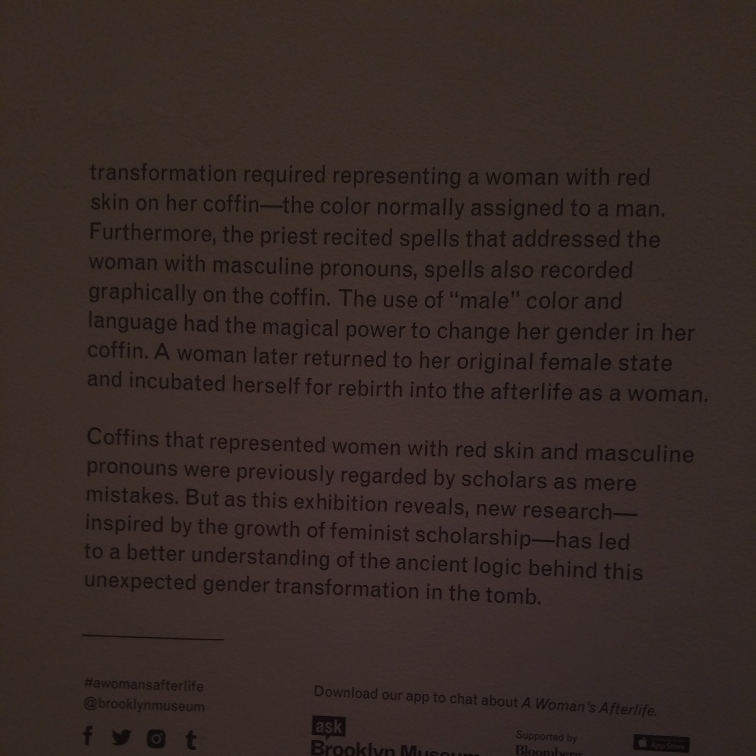
You're right. It was used for both, but it is symbolic of men and masculinity. The only time a woman was painted red was when she was to be thought of as a man.
I think I understand. Generally speaking, men were red all the time, while women were red only at times when they were thought as men?
Yep!
Why are the colors different?
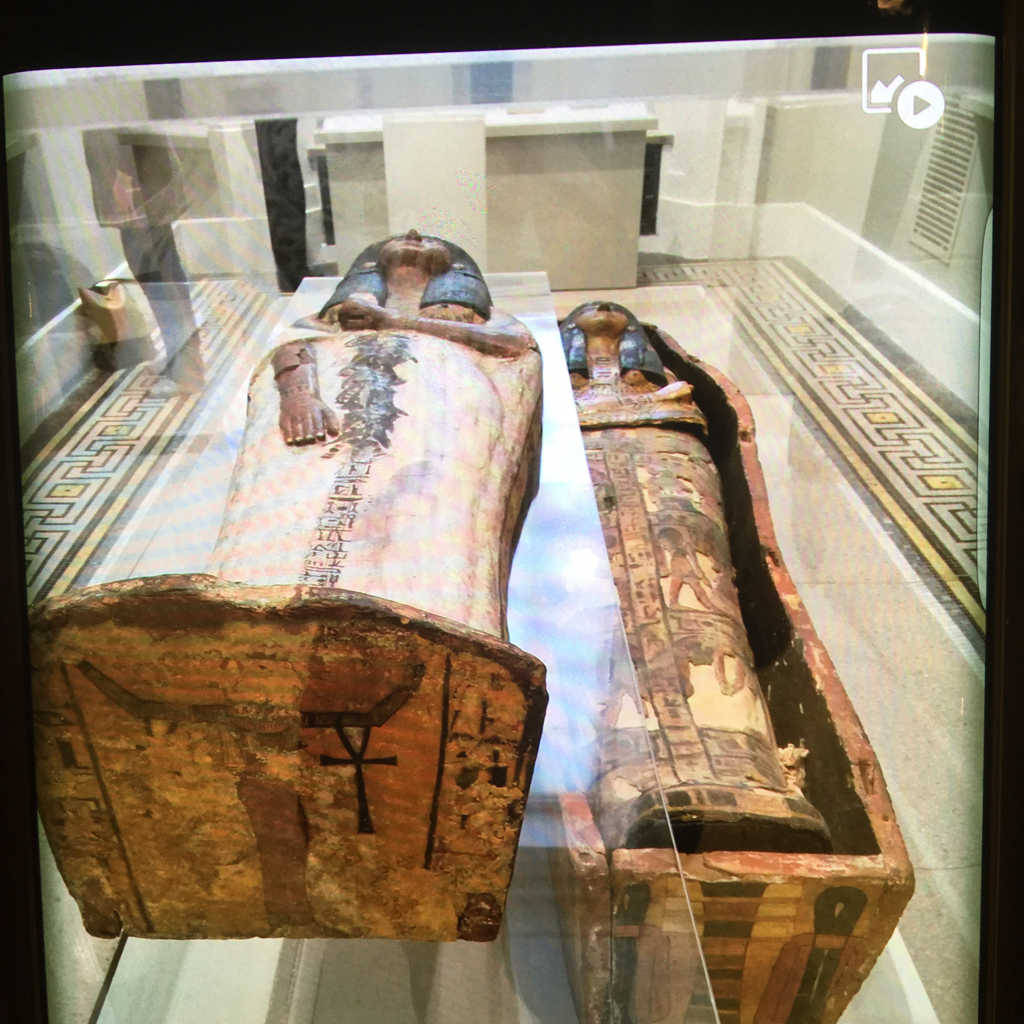
As you may have read on the label color and language played an important role in the afterlife for women. On the outer coffin Weretwahset is depicted as red, and on the inner coffin she is yellow. This is important because the Ancient Egyptians believed that women had to become temporarily male to be reborn in the afterlife. Red was associated with men, and yellow was associated with women. So in a sense Weretwahset is both male and female on her coffin.
I'm currently perusing A Woman’s Afterlife: Gender Transformation in Ancient Egypt. I was wondering if such elaborate funerary rituals were performed for all Egyptians, or just the elite classes?
Weretwahset/Bensuipet's coffin that you see in the exhibition would have been quite expensive and something that only wealthier people could afford. There were multiple types of coffins at different price points. Middle class people and above would have had some type of coffin.
So poor Egyptian women weren't "reborn" in the afterlife?
The poor would still be reborn, although they wouldn't necessarily have been able to afford the many accoutrements to assist in the process.
The wall didactics say Egyptian women had to be 'transformed' into men to conceive themselves for rebirth because it was believed men carried the embryo. Was there a second (female) party in this post mortem conception? Or did the woman, as a man, regenerate herself solo?
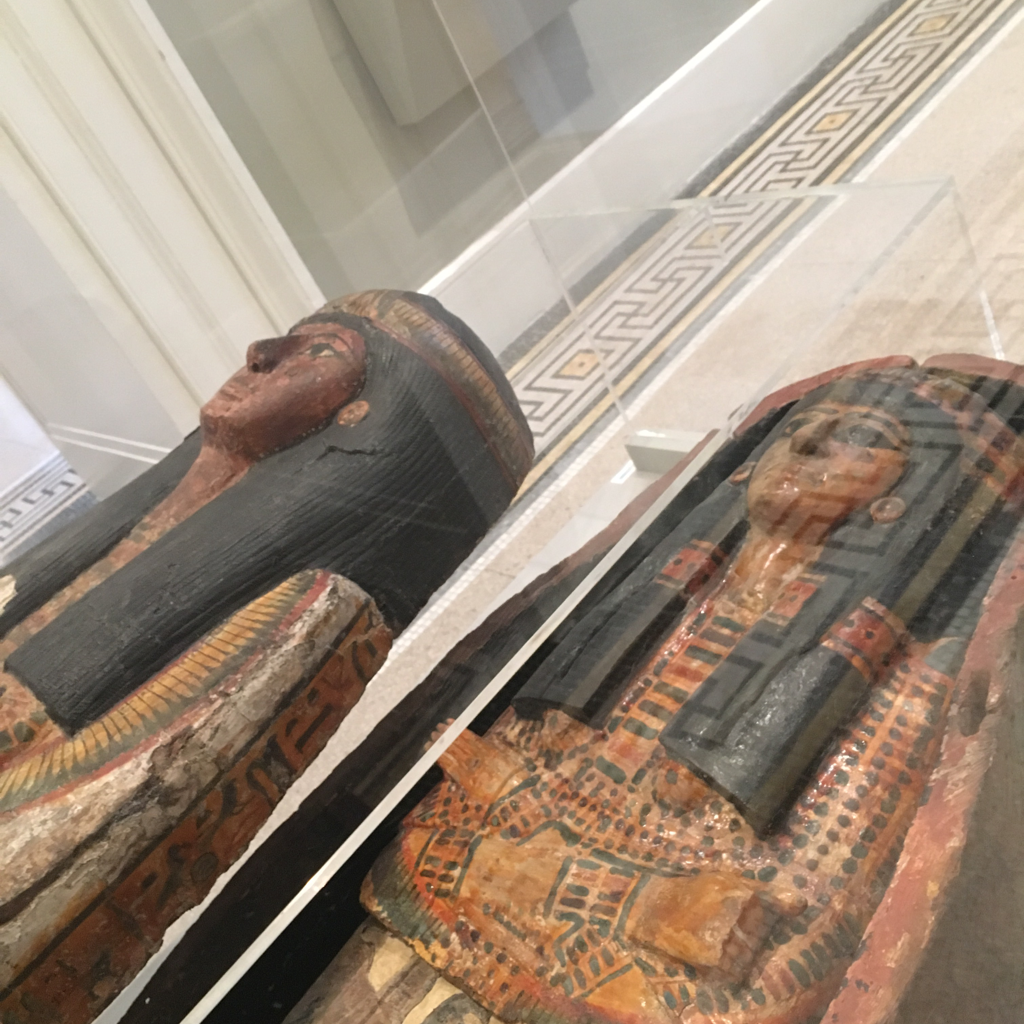
Ancient Egyptians believed that men were able to create a fetus and implant it into a woman. The coffin, which is the same as the word for 'egg' in Ancient Egyptian, acted as a womb when being reborn. Men, with this understanding of reproductive science, could just recreate themselves without a woman being involved. The deceased would have to do this alone, which led to the 'problem' of how women could be reborn and its various solutions. By becoming a man, briefly, a woman was able to create the fetus and the coffin was able to incubate it.
That's wild! And I did not know about the word for coffin/egg! Was the idea of female gender transformation introduced in scholarship pretty recently? How did scholars think women recreated themselves after death before that?
This idea was published pretty recently, in a 2010 article by Kathlyn Cooney. Before that, the issue wasn't examined too critically. Today, we know it takes male and female participants to create new life (at least in most complex species) and sometimes scholars take that kind of knowledge for granted.
Thank you, I definitely would not have been able to Google this. Very insightful!
What is the new scholarship that has lead to the conclusions that "A Woman's Afterlife" is based upon? Also, is this specific to a particular time period?
The initial article analyzes coffins from the late New Kingdom, but I'm not sure if the phenomenon is limited to that time period.
This new interpretation is based on language and iconography. On their coffins, like Weretwahset's, women are temporarily referred to by male pronouns and sometimes even shown with red skin (a sign of male-ness in contrast to yellow skin for females).
Previously, some scholars interpreted these instances as mistakes, but Cooney points out that the phenomenon is too common to always be a mistake and instead must serve a purpose.
Could you share the title of the article? Would love to learn more!
Of course! It's called "Gender Transformation in Death: A Case Study of Coffins from Ramesside Period Egypt" and was published in the journal called Near Eastern Archaeology in 2010.
Is this real? Like is there an actual mummy in there? Or is this for decoration?
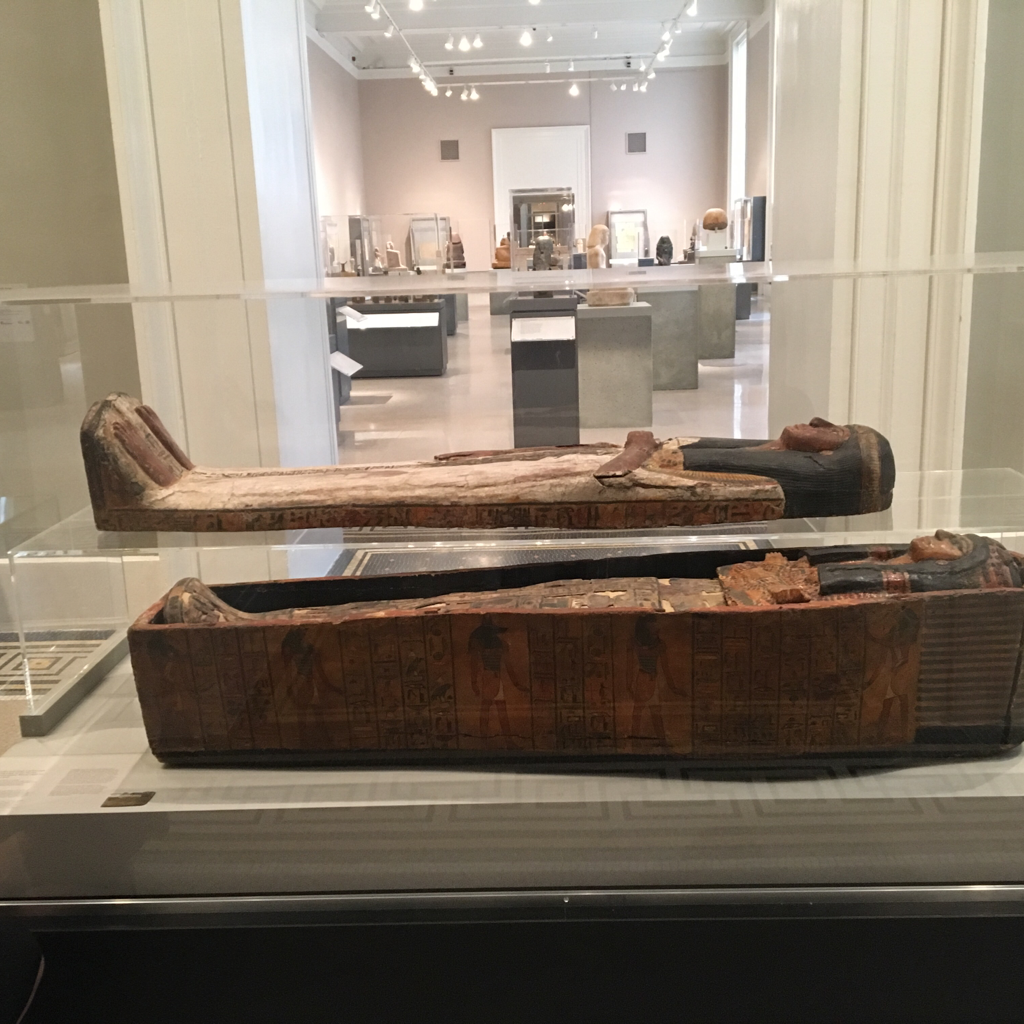
Yes. No. Kind of. This is a real coffin from ancient Egypt and it did contain a mummy when it was acquired by the Museum, but Bensuipet's delicate mummy is being kept safe off of view right now. Coffins and mummy boards like these were designed to be beautiful, protective, and transformative for the deceased.
Does the Coffin of Bensuipet have an inner container?
It sounds like you're looking at what's called the mummy board. It's a single decorated panel placed on top of the mummy before the coffin is closed with the actual lid.
So in this exhibit we don't see the mummy?
That's correct, the mummy itself is very delicate and has not been included in this exhibition.
There are mummies on view in the Mummy Chamber section at the opposite end of the Egyptian galleries if you're interested!
If it is necessary to turn a woman into a man so she can conceive her fetus for her next life, why isn't it also necessary to turn a man into a woman so he can incubate his fetus in the afterlife?
The coffin served as the method of incubation for the fetus in ancient Egyptian conceptions. The word for "coffin" was the same as the word for "egg," so the coffin the deceased was placed into served a role in the rebirth process.
Thank you, that was very helpful!
Is there are real mummy in this coffin?
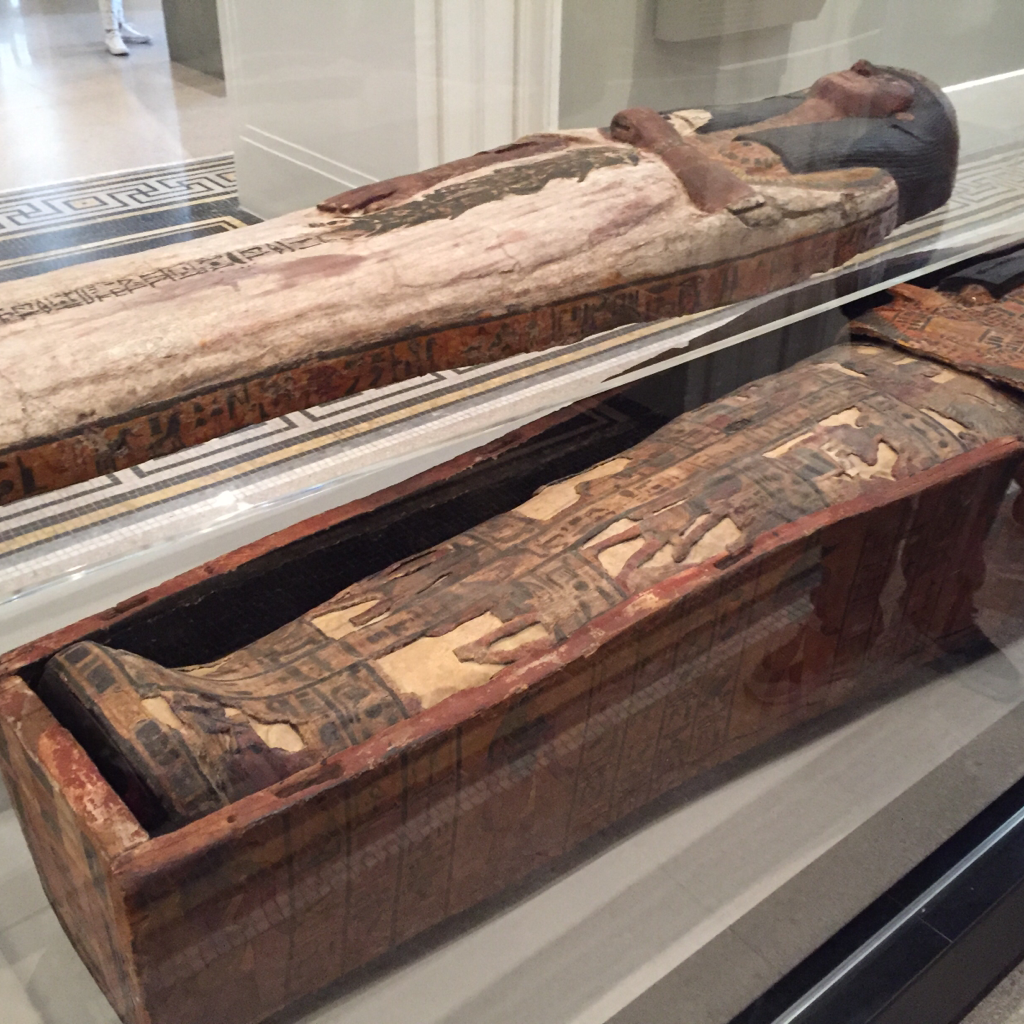
There is not a mummy inside this coffin. If you want to see some some mummies, head to the other side of the Egyptian galleries, the Mummy Chamber.
Where did the belief that a man created the fetus come from? Is there some story that established that?
They believed that the man created the fetus and that it was transferred to a woman during intercourse. It can sometimes be difficult to pinpoint the origin of ideas such as these which are based largely in myth and religion.
I see, thank you!
Were moms usually buried with their children?
Sometimes members of the same family were buried in the same tombs, and they would use the tomb for several generations. If families were very wealthy or royal, family members could be in separate tombs but in the same complex, very close by each other. Ancient Egyptians had a strict sense of where to bury the dead and there were many cemeteries. I'm not sure if they had family groupings in the larger cemeteries for people who couldn't afford tombs.
Thanks.
If Egyptian priests recognized that a woman was necessary to incubate the fetus for rebirth into the afterlife, wouldn't that also necessitate a gender transformation for males seeking rebirth? They would be able to produce the rebirth fetus, but then how would it be incubated? Is there any evidence of female-gendered language and colour found in/on the sarcophagi of male-sexed Egyptians?
For the ancient Egyptians, the coffin fulfilled the role of the womb when being reborn into the afterlife. The word for "coffin" in ancient Egyptian was the same as the word for "egg." The "problem," as they saw it, was that women could not create the fetus needed to be reborn into the afterlife. Language and color-usage were the ways in which they eventually "solved" the issue. For men, none of that was necessary as they could create their own fetus and the coffin would incubate it.
Awesome, thanks!
Was the gender transformation rite indicative of a broader patriarchal society? What was the position of women in ancient Egypt?
To a degree, ancient Egyptian society was patriarchal but not so much as, say, ancient Greek society. In ancient Egypt, women could own property and represent themselves in court, for instance. The issue that led to women needed to become men, briefly, to gain entry into the afterlife was more a misunderstanding of biology. In ancient Egyptian medicine, it was thought that the man creates the fetus and the woman carries it to birth. So while a man could create a fetus on his own, a woman couldn't.
Did the ancient Egyptians believe afterlife was genderless state?
The ancient Egyptians did not believe the Afterlife was a genderless state. They did believe that the soul was reborn in the afterlife and that women would often have to be briefly transformed into men in order for this rebirth to take place, but would turn back into a woman and exist in the afterlife.
Rebirth in the afterlife was complex and involved the division of the person into many parts, including the physical body and a spirit sectioned into the Ka, or spiritual double, the Ba, or the individual's power, and the Ren, or the person's name.
These were often manipulated in writing or art related to burial to achieve the desired effect. For instance, by painting a lady's coffin red, the typically male skin color in Egyptian art. This can be seen in the A Woman's Afterlife exhibition.
Can you give us some evidence of the theory expressed in the Gender Transformation exhibition?
Sure! Is there a theory you were particularly interested in? The basis of the idea of the exhibition is that words and imagery, as well as ancient Egyptian texts, indicate that woman, at least iconographically, briefly were rendered male in order to conceive themselves and be reborn. The exhibition takes such material evidence as the red skin and male pronouns used on women's coffins as intentional, rather than a mistake. The basis of the theory is that you would read these changes as intentional decisions that were affected at certain times in the process of death and rebirth, as opposed to the older theories relying on the assumption that the ancient Egyptians had made a mistake.
Where can we get more information on how this theory was formulated?
The primary scholarship on the theory is by Kathlyn M. Cooney, in "Gender Transformation in Death: A Case Study of Coffins from Ramesside Period Egypt"
You can see material evident in the exhibition in the "Coffin of a Lady of the House, Weretwahset, Reinscribed for Bensuipet Containing Face Mask and Openwork Body Covering." Generally, women in Egyptian art would be shown with yellow skin, and males with red skin. Here, a woman's coffin is painted red, a decision that previously had been read by scholars as a mistake or an anomaly but in the context of new feminist scholarship can be seen as a magical intervention.
The fact that her cartonnage underneath contains a mask with yellow skin again lends support to the theory as well.
Thank you! Lots of good info. Will look for that article.
Where is her tomb located?

This coffin most likely comes to us from a tomb in Deir el-Medina which is the modern name of a village within the Theban Cemeteries (which includes the Valley of the Kings). The village was home to the artists and artisans who built the tombs.
How many Egyptian women had the ritual done to temporarily turn them into a man so they could be reborn?

In theory, all women would go through that process. It wasn't a ceremony that was actually practiced by living people, but more the way that the ancient Egyptians rationalized women being able to be reborn the same way they imagined a man would. The process isn't even described anywhere (at least that has been discovered so far). The only reference to the transformation is that women were temporarily referred to by male pronouns and painted a male color within the narrative of their journey to the afterlife depicted on their tombs and coffins.
How do we know that women were "transformed" to men in death? Is it all just conjecture? Or does it just mean women get extra attention. Not just red paint, but more paint!
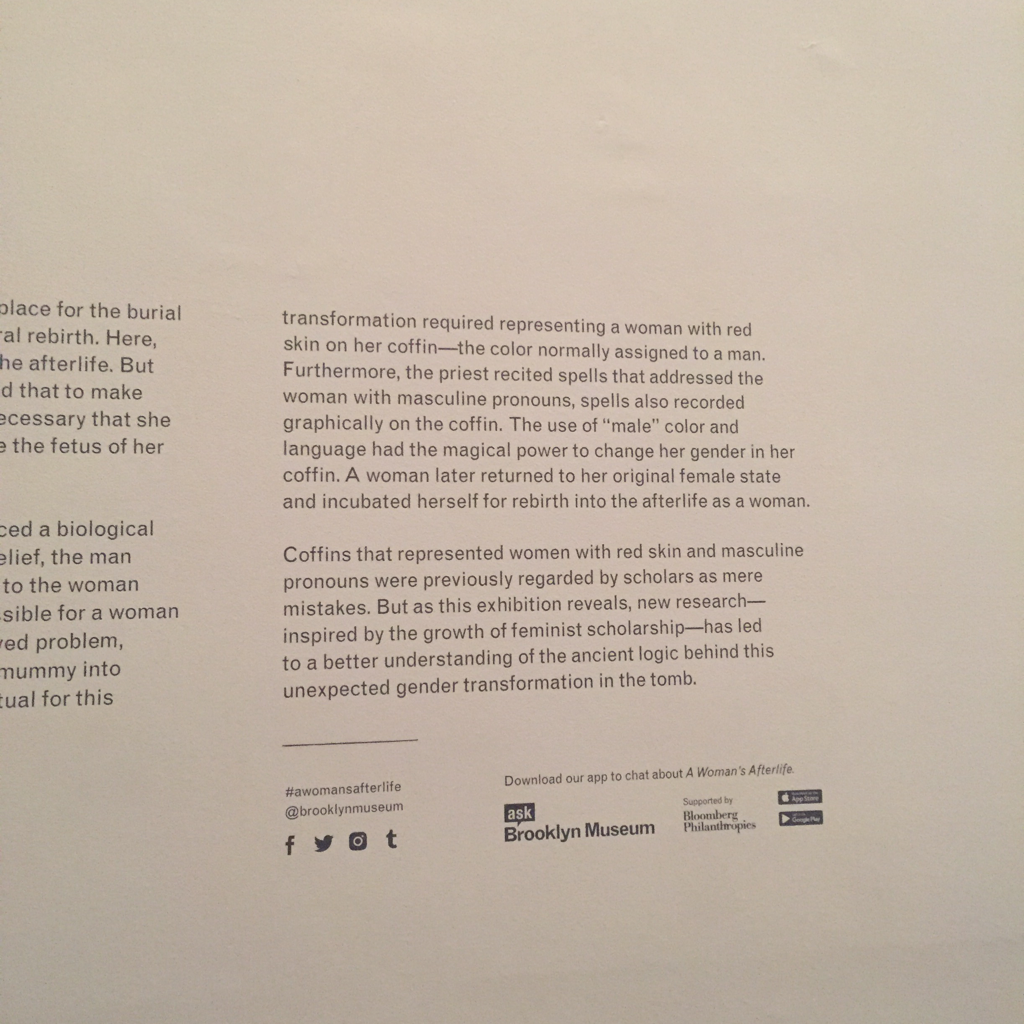
While there isn't definitive proof, the hypothesis is supported by various coffins excavated from the Ramesside period that show women with red paint, which is traditionally associated with men. This, in combination with the use of male pronouns on parts of these coffin's inscriptions have led scholars to believe that this was a form of symbolic transformation to allow for a woman's rebirth in the afterlife. At first, many archaeologists and Egyptologist believed that use of the different pronouns were a mistake and simply dismissed them (mostly male), but with the rise of women in the field a reexamination of this evidence has proven that there is a definite connection.
How do we know those pronouns are definitely male? Or just gender neutral?
We have translated the Egyptian language and are sure that there are certain pronouns that refer exclusively to women while others are used for men.
If you take a look at the coffin and cartonnage you can see this connection quite clearly. On the outside Weretwaset, who we know is a woman, is depicted with red face, hands and feet.
She is also referred to with a male inscription on the outside. However her inner cartonnage she is yellow. This is kind of a visual representation of how the male transformation is temporary and the person is "reborn" into a woman in the afterlife (how she is portrayed in her cartonnage). You're welcome!
Pretty neat connection
Why is it that the women had to be turned into a man to create the fetus, but men did not have to be turned into women for incubation? Who did the incubating for a man's rebirth?
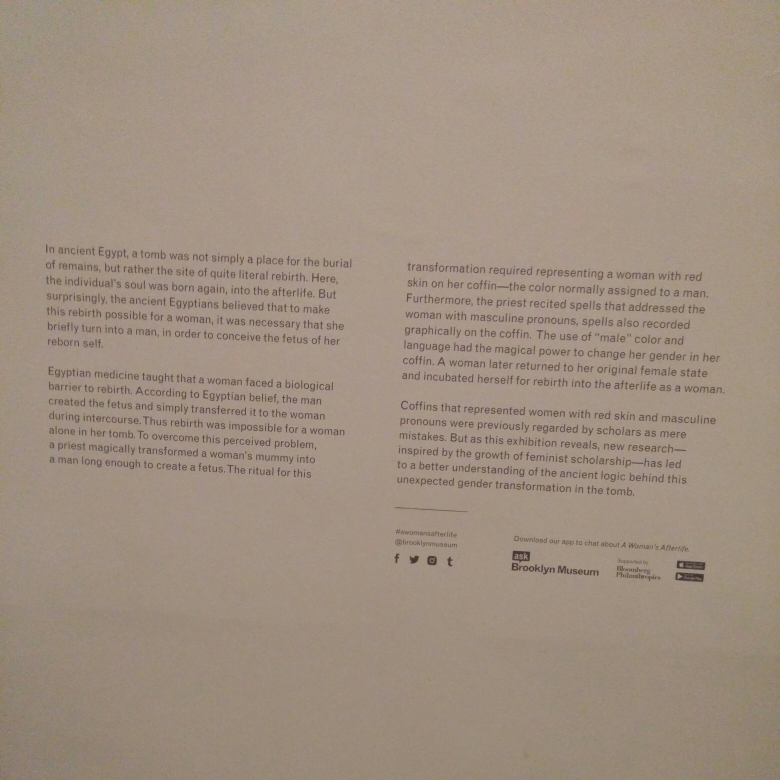
In the case of men, the coffin acted as the womb. The ancient Egyptians believed that the fetus was entirely created by the male parent and the the woman was just a vessel. Following that understanding, a woman had to be transformed into a man to recreate herself as a fetus.
Are the mummies really thousands of years old? Is there one in here?
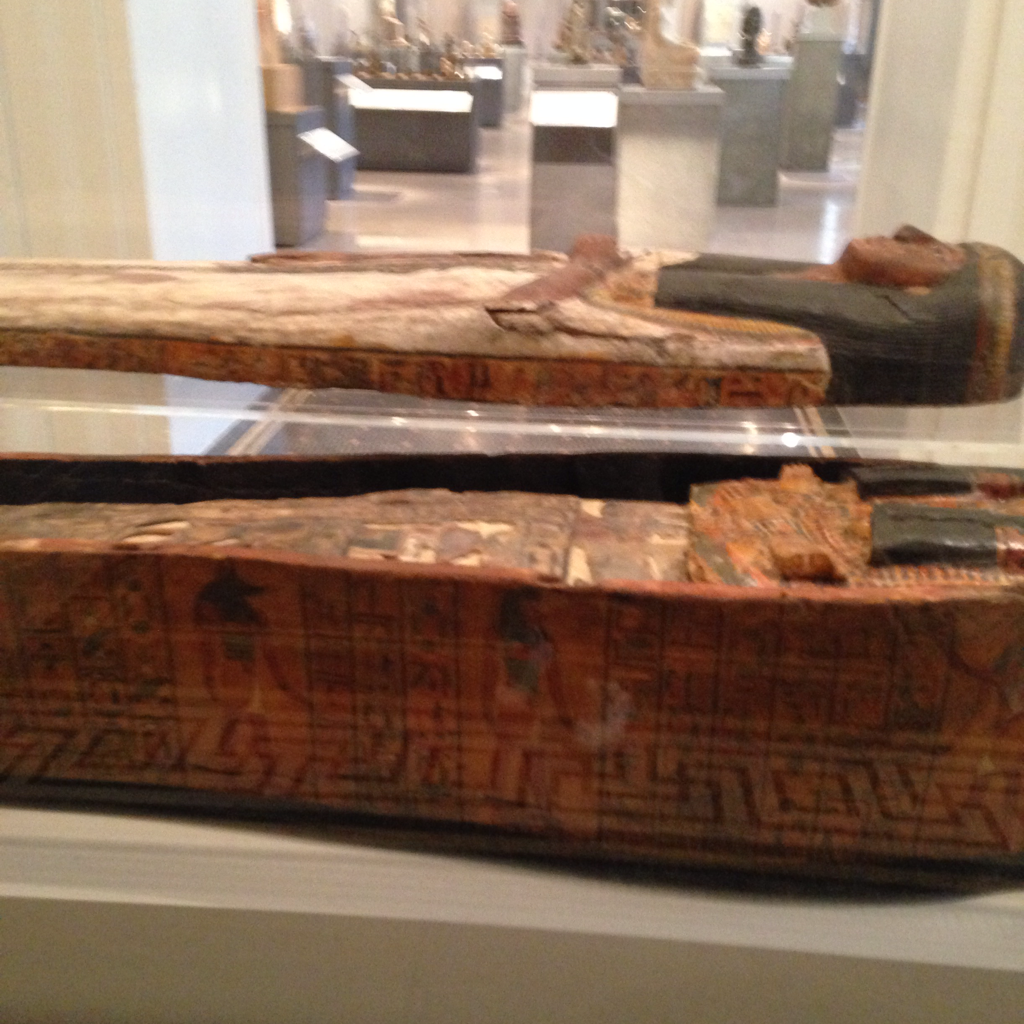
All of the mummies on view are real and are thousands of years old! This coffin does not currently contain a mummy though, there is special padding inside to hold the mummy board up.
If you head to the other end of the Egyptian galleries, to the Mummy Chamber, there are three mummies on view from about 1700 to about 2700 years old!
Tell me more.
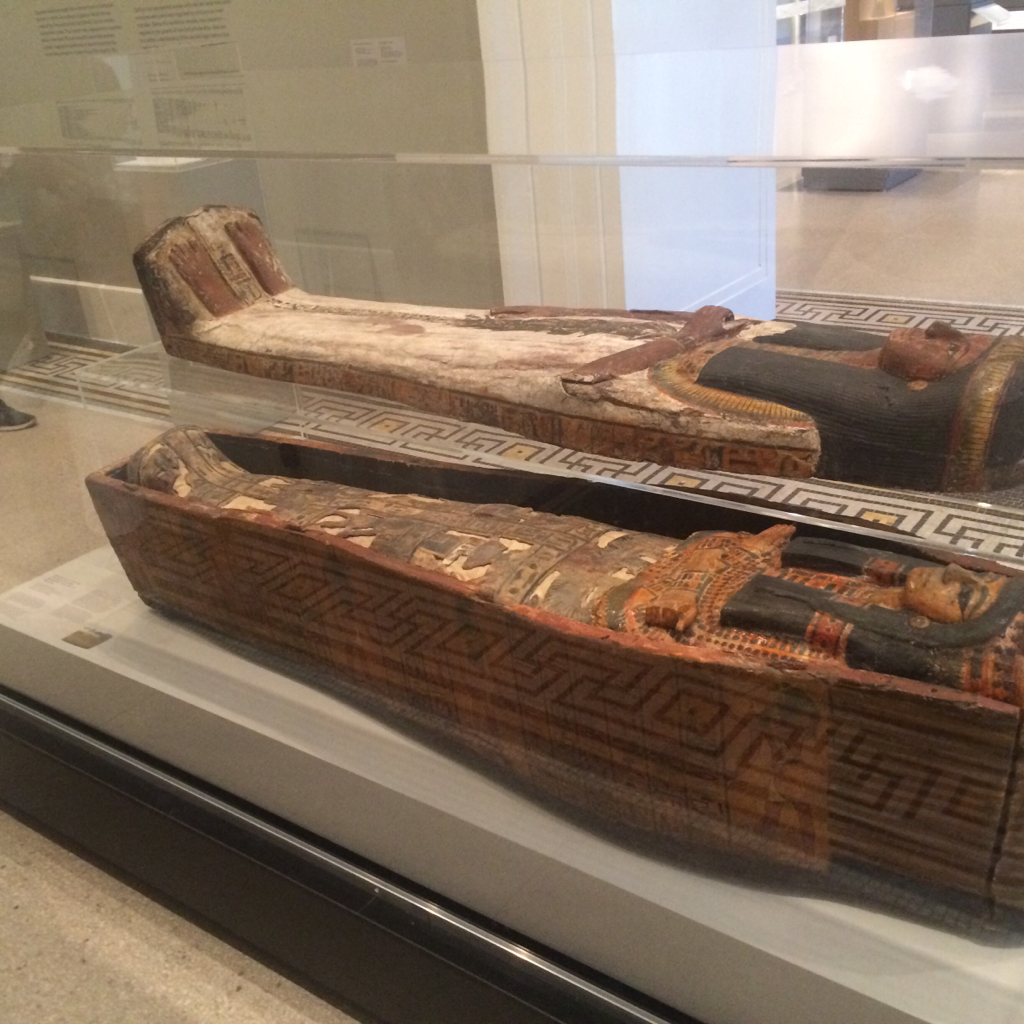
Did you notice the differences between the outer lid and the inner mummy board? Bensuipet is show red on the outside meaning she was temporarily male. Her face is yellow on the inside showing that she has changed back to a woman and will live out eternity as one.
We are not sure how the rebirth transformation happened.
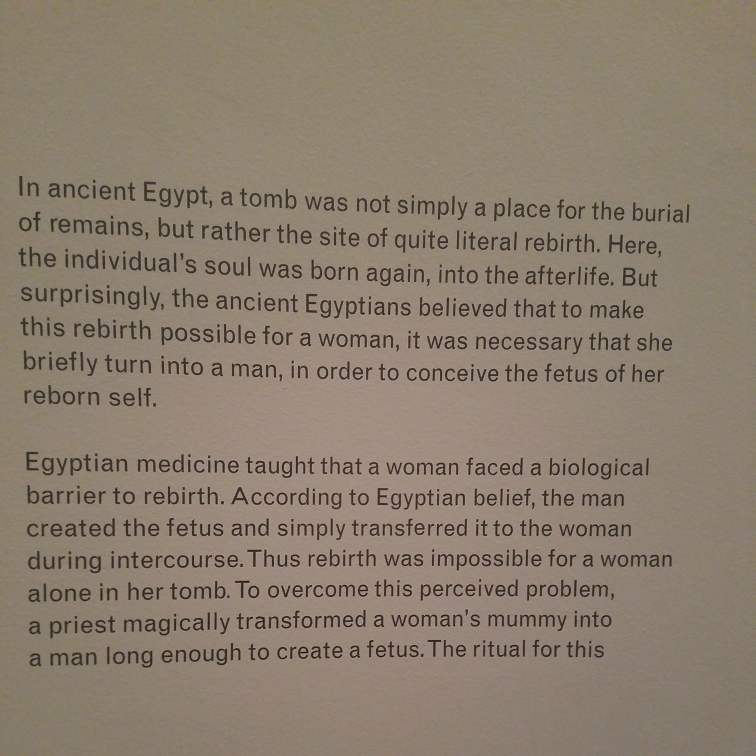
Truthfully, no one is really sure. We know that the ancient Egyptians believed that rebirth could only happen through an actual birth into the afterlife. We also know that the ancient Egyptians believed that the fetus was created by the male.
Based on those beliefs and the instances of women referred to by male pronouns in a few places on their coffins (like in the case of Bensuipet in this gallery) scholars have a theory that the Egyptians believed that a woman would transform into a man, temporarily, after she died, in order to conceive herself so that she could be reborn.
The placement of the hand on the inside and outside is different. Does this have a special significance?
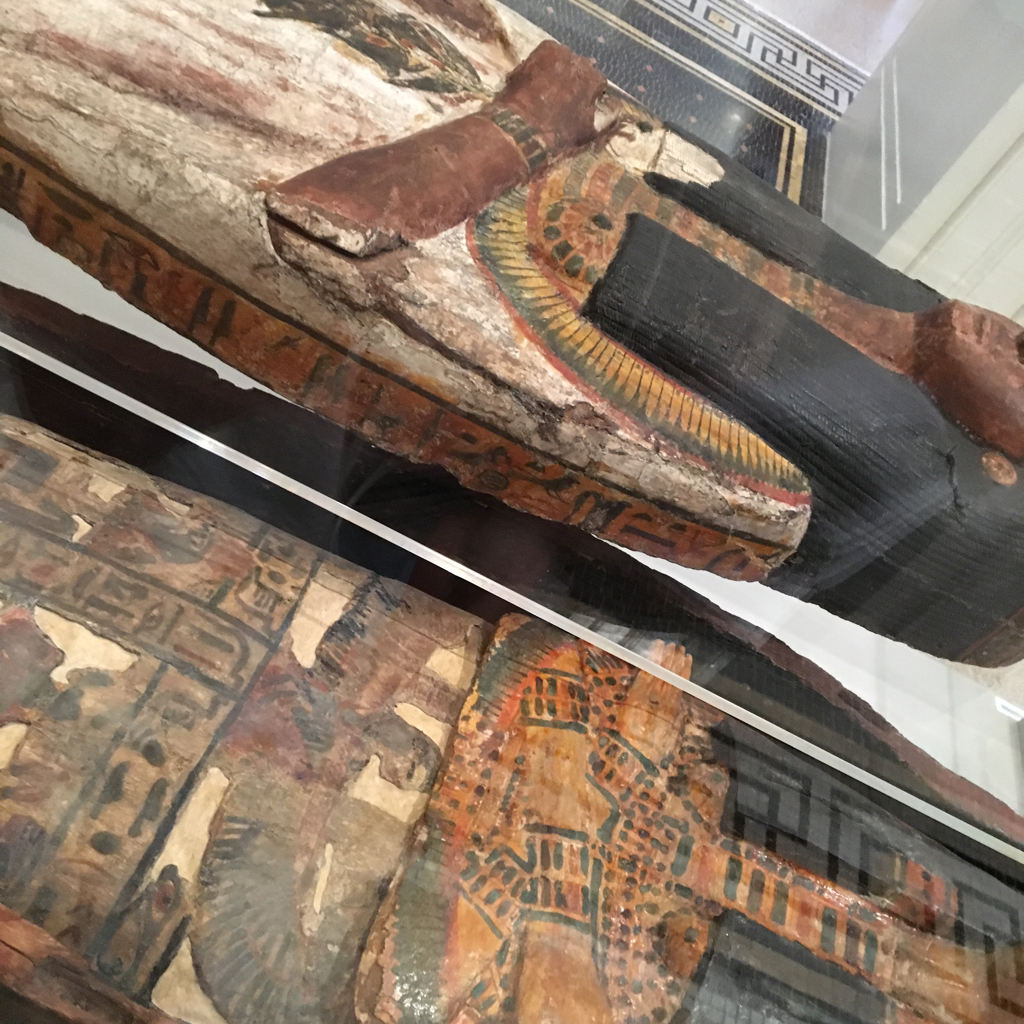
Great question! The hands are positioned differently because these portions of the coffin represent the individual at different states in her rebirth and journey to the afterlife.
The coffin with the red skin shows Weretwahset with the skin color usually reserved for men, representing her as male so that she can provide the "seed" to give birth to herself. Her arms are in a position associated with life in this version, one arm held just below her breast and the other at her side.
The coffin with the yellow or golden skin shows Weretwahset as she was at death, as a woman, and as the deceased, both her arms crossed atop her torso in a position that indicates the sick or dead.
Both are part of her journey to the afterlife, but, of course, the red coffin most strongly illustrates rebirth!
Thanks.
What is the meaning of the decoration around her neck? Is it jewelry that represents her wealth?
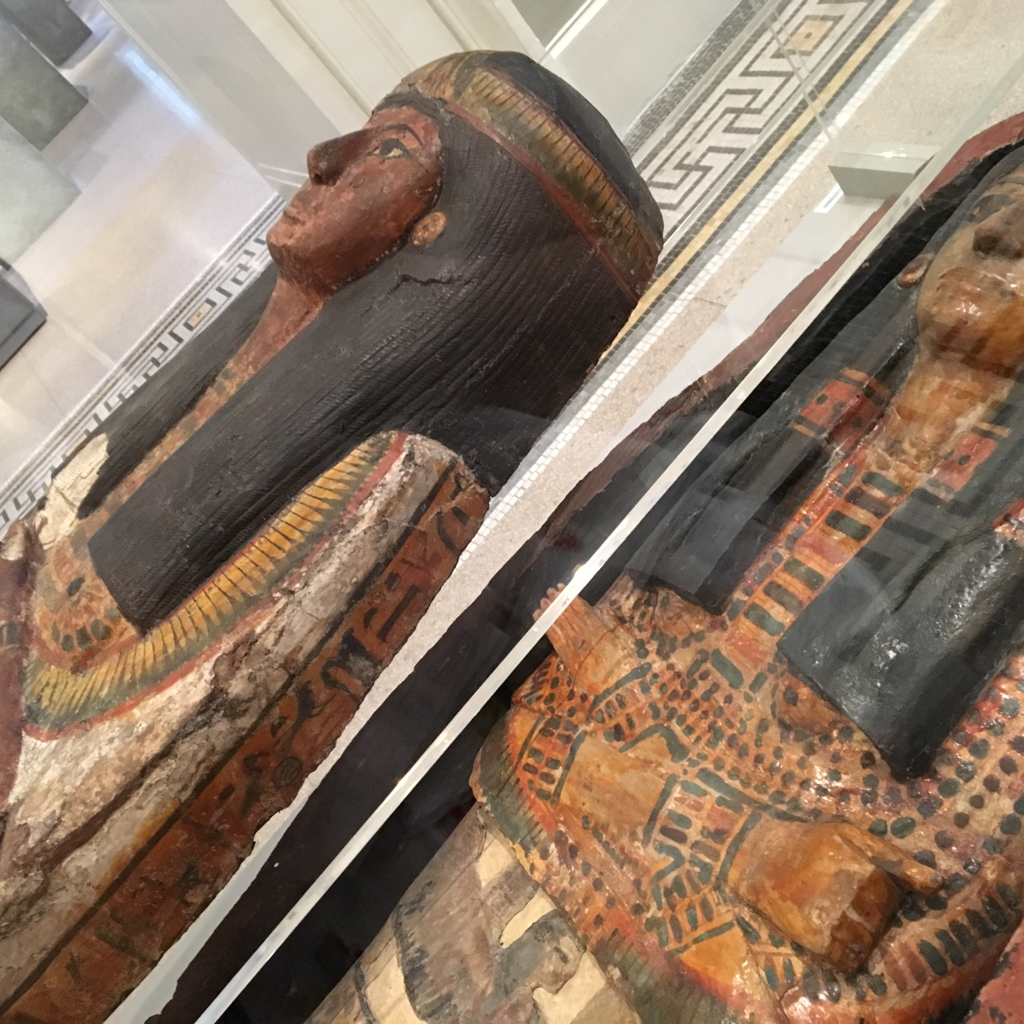
Exactly, much of the painted decoration, particularly around the faces and necks, represents jewelry!
Depictions of the broad collar were popular when decorating mummies, a reference to the story of the gods Isis and Osiris conceiving their son, and therefore a reference to rebirth!
Men and women of all social statuses wore jewelry for protective purposes and fashion. However, as you would imagine, more elaborate jewelry was also a symbol of status.
So could only the king and his court create coffins for themselves or could everyone do it?

By the time of this coffin, what your burial looked like was more a matter or money than of status (though the two are often linked). People of the upper middle class (and wealthier) certainly would have had some type of coffin. There is also evidence of working class people saving up money to be able to afford a coffin.
Often, people of lower classes would get reused coffins. In fact the coffin that you are looking at, that of Weretwahset, was one such reused coffin!
What do all the different decorations represent?
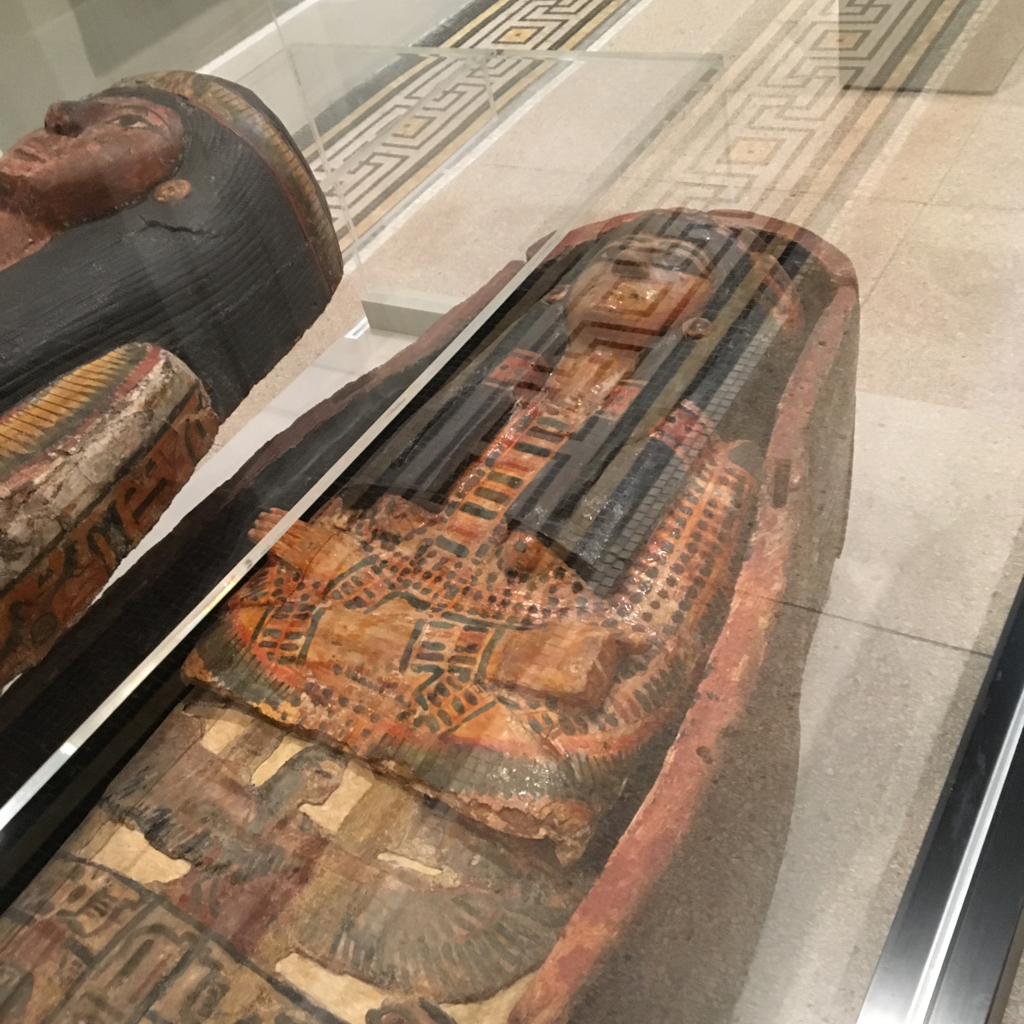
The decorations include a couple different elements, the most obvious is clothing and jewelry. There also images of gods, and, of course, lots of text. All together, the purpose of the coffin is to identify, protect, and transform the deceased.
The clothing and some some texts identify her. The gods and texts protect. Some of the text and also the different colors used for her skin help to transform her.
The ancient Egyptians were very concerned with making a successful journey to the afterlife as well as a having a comfortable afterlife once there. All of these decorations and all of the tomb equipment are designed to make the journey and the afterlife easier.
What's this?
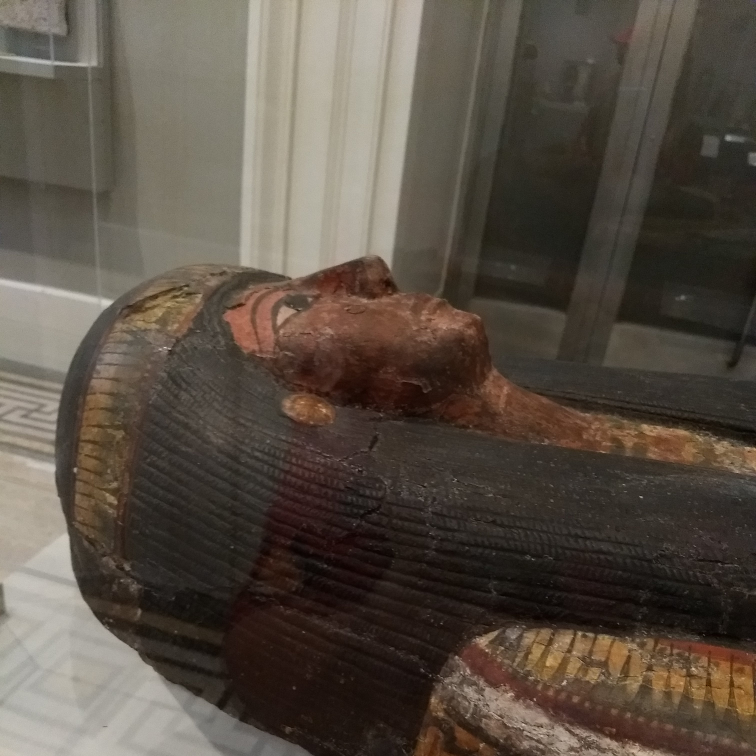
That is a coffin sculpted and painted to resemble a woman named Weretwahset. A mummy would have been placed inside the coffin beneath the mummy board you see to the right. The decorations serve to identify, protect, and transform the woman inside.
Is there someone in there?
There isn't someone in this coffin currently. While it did contain the deceased when it came to the museum, the remains were too fragile and are not inside the coffin while it is on display.
Tell me more.
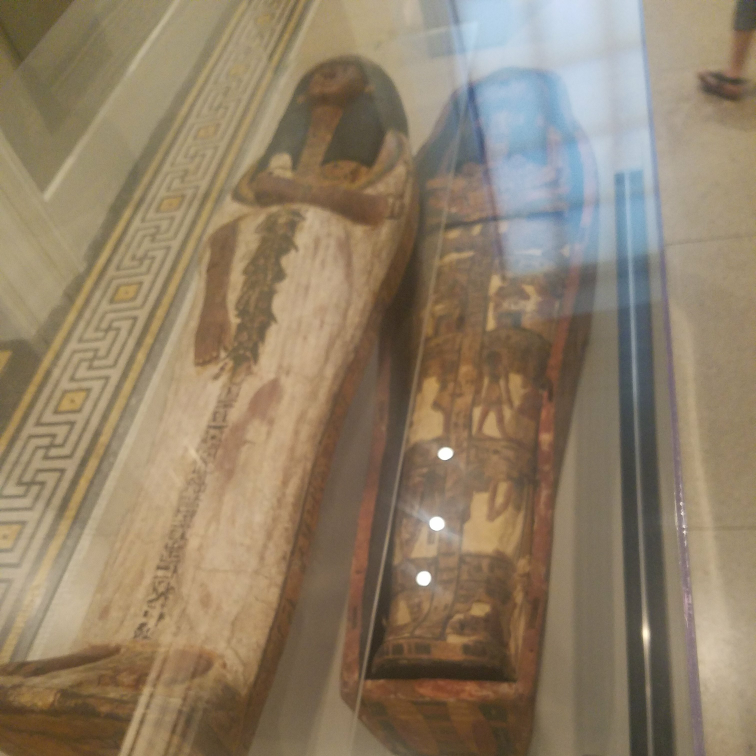
You'll notice that on the outer coffin Bensuipet is painted red, while on the inner coffin she is painted yellow. Red was commonly used to depict men in Egyptian art, while yellow was used to depict women.
The theory goes that Bensuipet was painted as both male and female on her coffin as a physical representation of the way in which she would have to transform briefly into a man in order to give birth to herself in the afterlife.
Thank you for your help today.
Now, after the Weretwahset enters the afterlife as a male does she turn back to female?
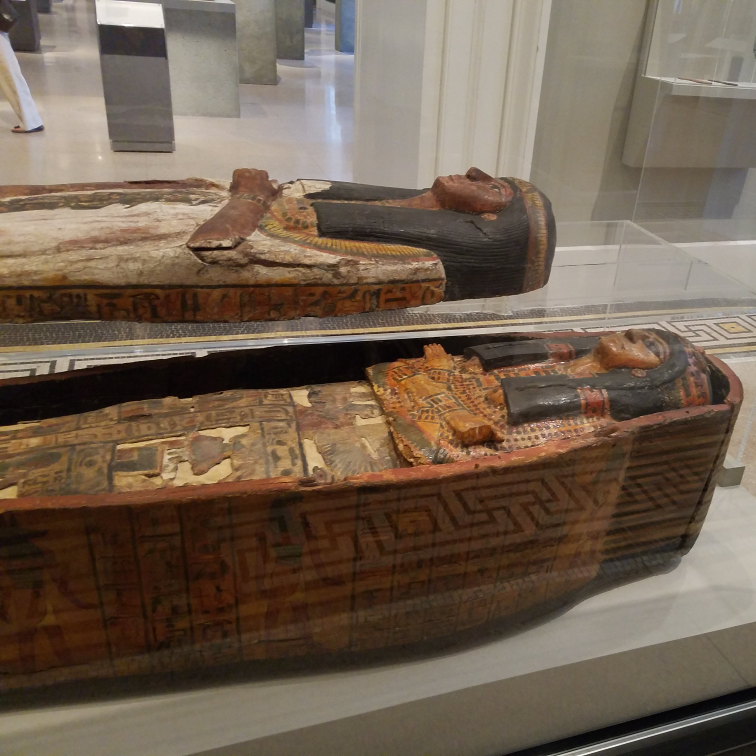
She does become female again in the afterlife. Essentially the ancient Egyptians believed that males provided all the information needed to make a baby, like a seed from a tree, and that women simply carried that seed and allowed it to grow. The woman would turn into a male briefly after death so that she could supply the "seed" needed for her to be reborn in the afterlife.
Interesting a self insemination? Reborn within herself.
Pretty much, yes!
Are Bensuipet's remains still in her coffin?
No, the only three mummies that are on view right now are further down in the Egyptian galleries in the mummy chamber. They are named Demetrios, an Anonymous Man, and Hor.
Thanks! Where are the other mummies stored? Are they here in cold storage?
Yes, several of the other mummies that entered the Brooklyn Museum's collection are in our climate-controlled storage if they are not traveling with exhibitions.
Are they ever visible to members?
Mummies that are appropriate for museum display are rotated into the galleries. Otherwise, they remain in storage.
Wonderful! Thank you so much!
What are some of the symbols on the coffin? Particularly towards the bottom of the coffin. It looks like loopy ropes?
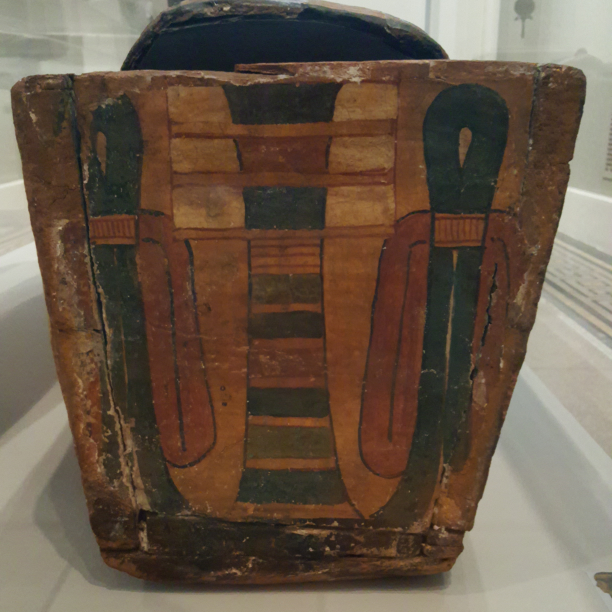
Those are hieroglyphs tyt, djed, and tyt again. Tyt is a symbol of the goddess Isis and is sometimes referred to as an "Isis knot," so "loopy ropes" wasn't far off! It also symbolizes the protection of the goddess. Djed is a symbol of enduring strength and is said to look like the spine of Osiris, the king of the afterlife.
What are these symbols?
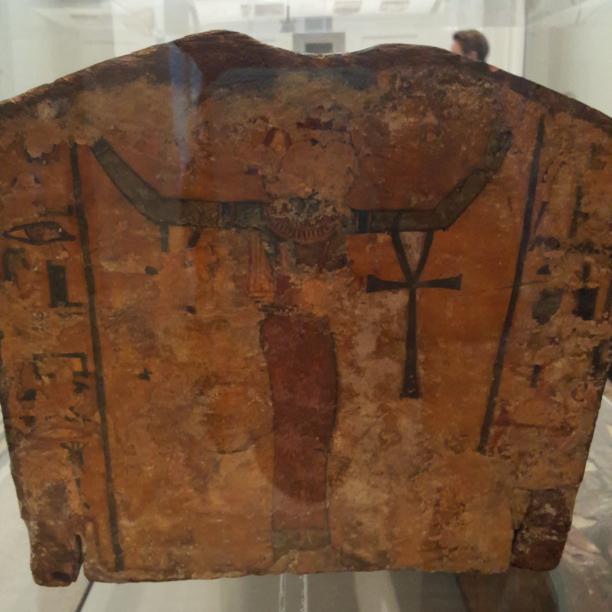
Here, the figure is a goddess, either Isis or Nephthys, it's difficult to tell with the damage on the head. The two goddesses were sisters and appear frequently in funerary equipment. They mourn for the deceased as they did Osiris when he was a legendary king of Egypt who had been killed. She also has ankhs hanging from each of her arms. This is a symbol of life in ancient Egypt and the hope for eternal life.
I know the bottom of the coffin was built and assembled in pieces. But what about the arm and feet of the top portion of the coffin? Or was the crack just a coincidence?
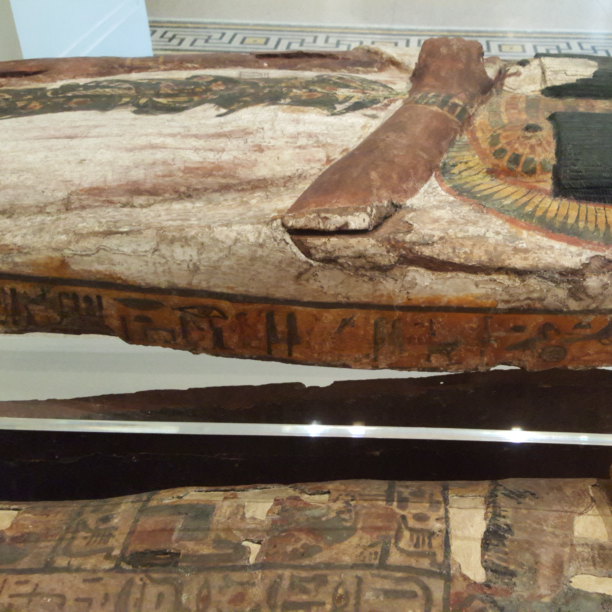
The lid was also created from a few pieces of a wood so I can't be sure if this crack is along a joint or along the grain of the wood.
There are 5 figures on each side of the coffin. Are these the priests transforming the body during the magic spell?
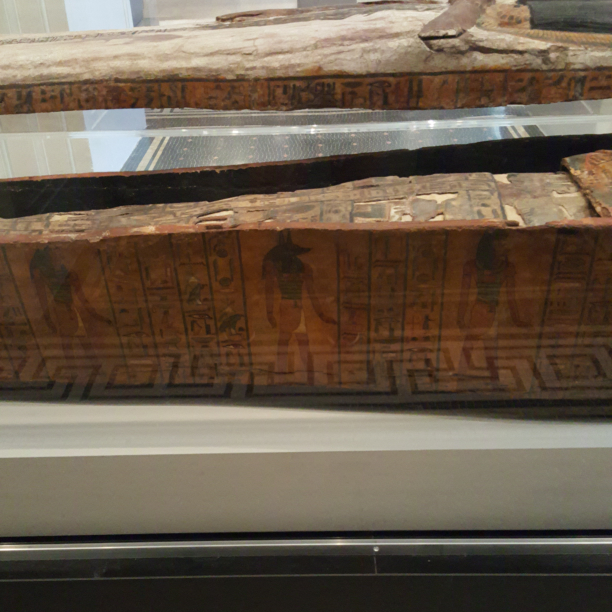
The five figures on the side of the coffin are the Four Sons of Horus and the deceased, Bensuipet. Imsety, the god closest to her is speaking to her and addressing her with a male pronoun which is a key piece of evidence for the gender transformation theory.
To our knowledge there is no description of a spell or magical process for this transformation, it seemed to rely entirely on the power of language which we do know that the ancient Egyptians took great stock in.
Thank you so much!
Were the Egyptians a matriarchal society?
They were not. They were not strictly patriarchal either, but men certainly did carry more weight than women and the king was always a man even if she was a woman. I'm curious, what made you ask that?
I though the thing about women in the tomb being "transformed" temporarily into men was interesting from a gender bending point of view. I was wondering if the Egyptians had a different approach to gender than western society.
Great point! We can't know exactly, the way that they thought about gender, but we can infer that a level of fluidity was understood. Evidence comes from things like the gender transformation in death and the fact the female pharaohs (especially Hatshepsut) were dressed as and sometimes referred to as men even though everyone knew they were women.
Oh that's cool! :)
Is there any meaning for the pictures on Weretwahset's coffin?
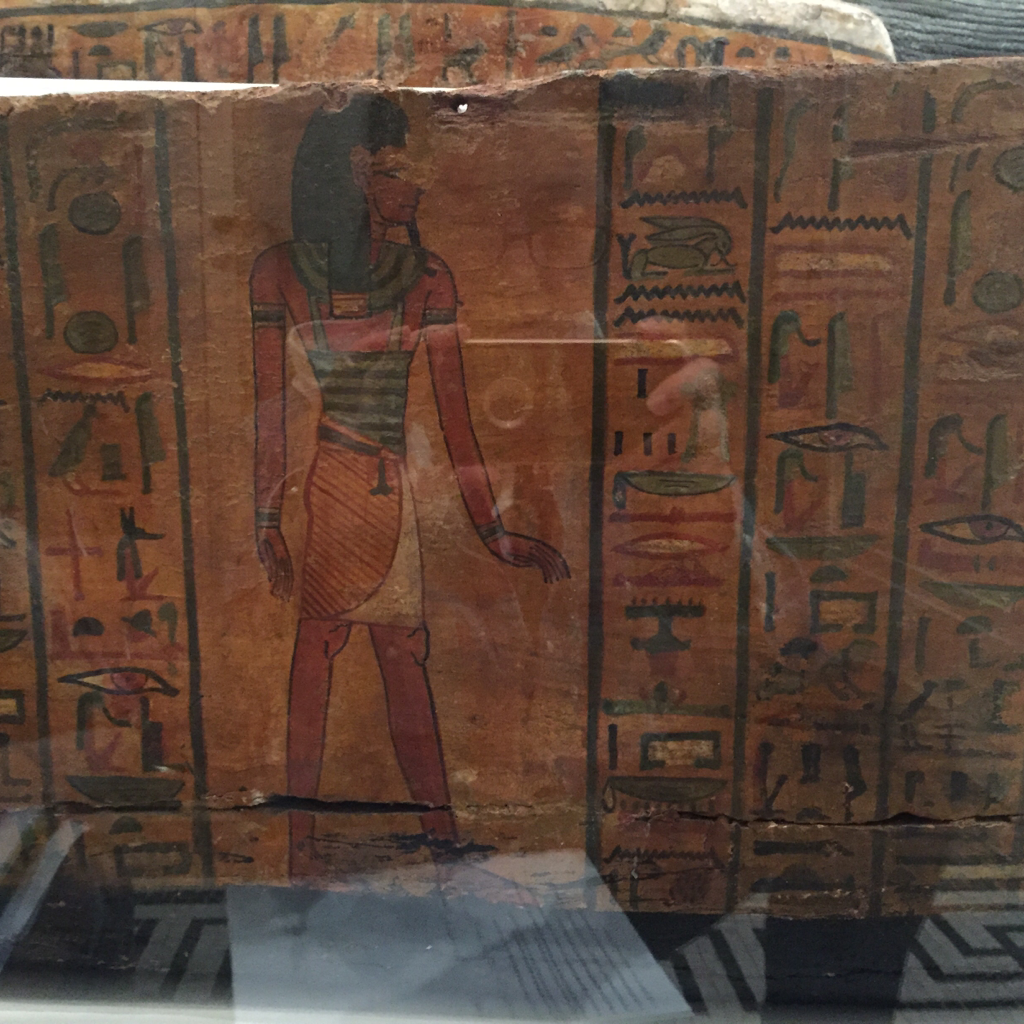
Yes! All of the figures and hieroglyphs have a meaning and significance!
So those small images are actually language? What do they often talk about?
Yes! those small images are a written language used in ancient Egypt. Here they are used to write spells and prayers to help the dead during their journey in the afterlife.
They often include the name of the person for whom the artwork was made.
What about the figures? Some look human and some don't.
Sometimes the figure is the person who has died. Other figures represent gods, many of whom are shown with animal heads.
For example, the god Horus is often shown with the head of a hawk. The god of wisdom, Thoth, has the head of an ibis bird.
I see thank you
What is the history of this coffin?
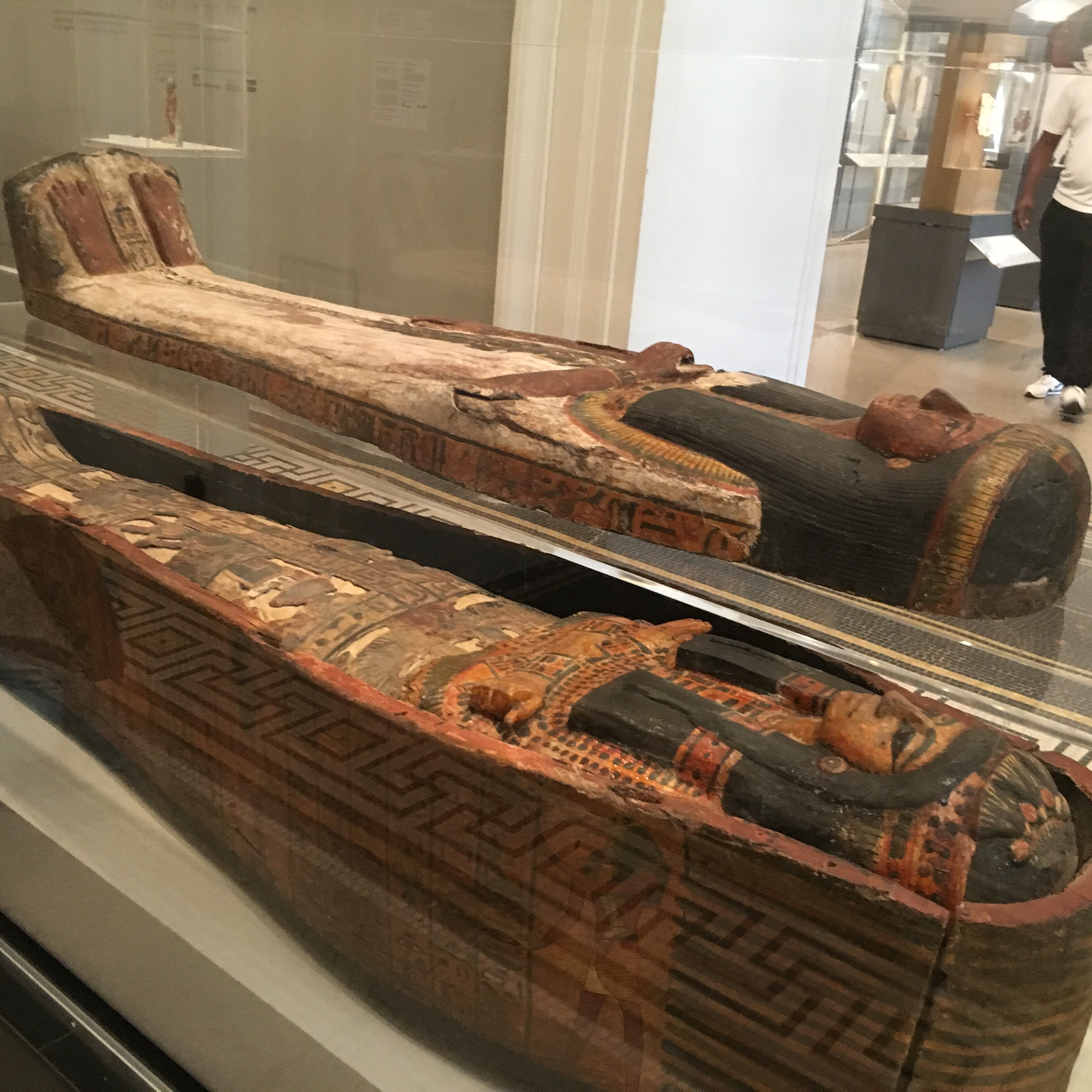
Interestingly, this coffin was originally made for a woman name Weretwahset, but it was actually used by a different woman, Bensuipet.
The significance of this coffin in this exhibition is that it illustrates the text referred to in the gender transformation theory. On the side of the coffin, you can see the god Imsety addressing Bensuipet and in the address he uses a male pronoun.
You can also see that her face his painted yellow (the color of women's skin in ancient Egyptian art) on the mummy board, but red on the coffin's lid.
When women are painted as men, what does that mean?
Are they women with power/association with males?
Are they women transformed into men (like a magical version of trans men)?
Were the figurines just repurposed, like the “woman” with her beard torn off?
I don’t quite understand the implication of the red-painted women.
"Women transformed into men" is the closest. However, based on the theory presented here, these figures are not interpreted as trans men in life, it's a temporary transition that takes place as part of the journey to the afterlife. The red skin represents the time when the deceased woman transforms into a man, provides the "seed" for her own rebirth, and then turns back into a woman to carry her own fetus to term. The reborn woman could then live forever in the afterlife.
Got it. I just used the analogy for wont of a better comparison.
I figured! That makes sense. That's actually a great example of how our modern language and ideas of gender affects how we view ancient cultures! That's something that new readings of archaeology are trying to address in instances like this.
What is Gender Transformation in Ancient Egypt all about?
It's about how the ancient Egyptians believed that, in order to be reborn into the afterlife, a woman would have to briefly transform into a man in order to conceive herself. She would then live out the rest of eternity as a woman.
The references to this transformation were very subtle, however. The centerpiece of the exhibition is a coffin that includes an inscription in which its female owner, Bensuipet, is addressed with a male pronoun one time.
Thank you
What color were the women's coffins in Egypt?
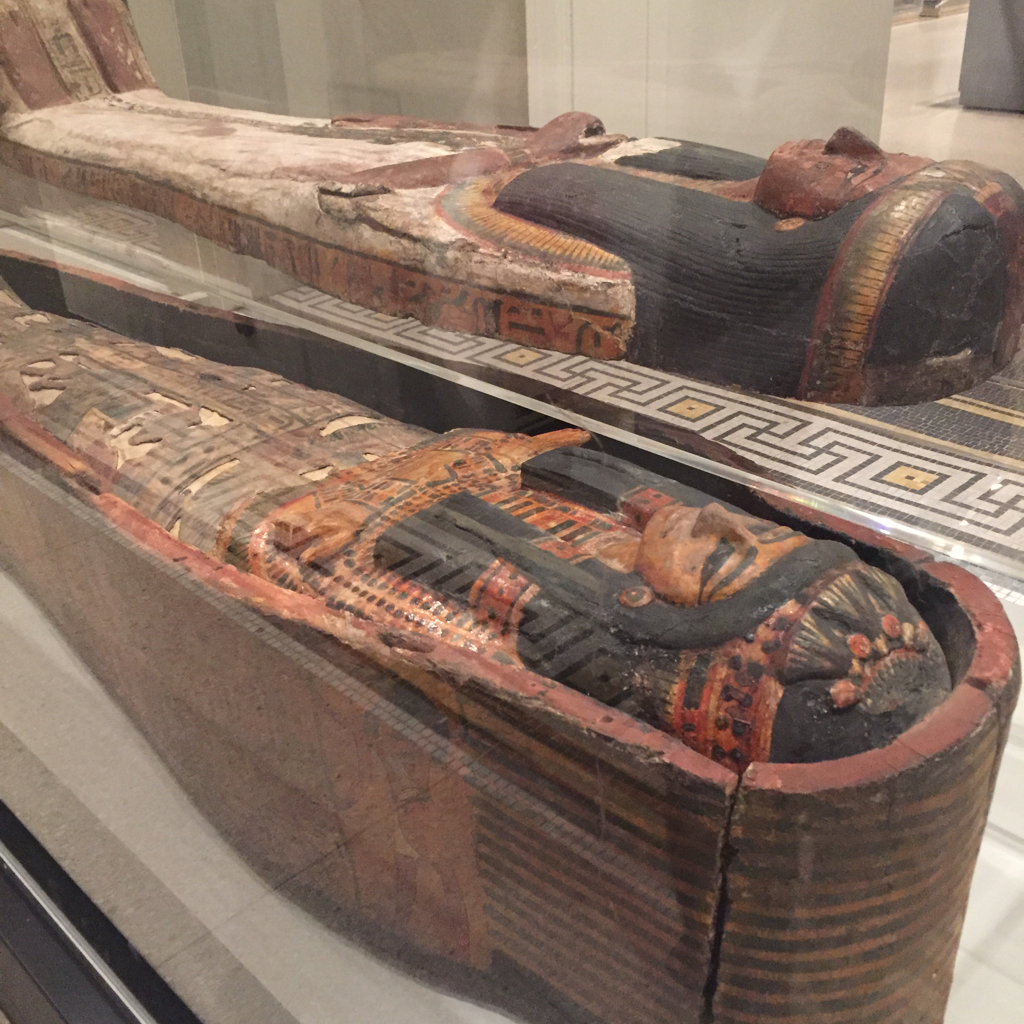
The ancient Egyptians most often used yellow, black, or white for wooden coffins of both men and women. This is an example of a yellow coffin (note the yellow sides). You can often recognize women as their skin is generally paler in color than men—yellow rather than red.
I wonder also if there's any text on the ideas of gender changing being necessary because of who carries the fetus and women needing to birth themselves. Why didn't men also need to birth themselves?
In the case of men, the coffin itself acted as a womb that could incubate the deceased's soul and rebirth them in the afterlife. Ancient Egyptians believed that the fetus was entirely created by the male seed and that, in this life, it was simply transferred to the woman for gestation.
Did ancient Egyptians ever not get into the afterlife?
There was a certain mythology surrounding the consequences of not living a good and noble life. When one died they were believed to navigate a landscape of obstacles before reaching the land of the dead where they would reside for the rest of eternity. If they passed all of the obstacles and tests including a judgement of the soul.
To help navigate these obstacles, they often employed the use of the spells and prayers that are first documented in the form of Pyramid Texts in the Old Kingdom, evolved into the Coffin Texts of the Middle Kingdom, and the Book of the Dead in the New Kingdom period.
One of the most popular scenes from the Book of the Dead, is the Weighing of the Heart ceremony where the deceased would stand before the gods and have his heart weighed against the feather of truth and recite a series of formulaic phrases in accounting of the good deeds he or she has done throughout their lives.
If the heart balances with the feather, access to the afterlife was granted. If it was too heavy with sin, it would be fed to the crocodile demon, Ammit. Ammit's punishment resulted in a second and permanent death.
Thank you!
What are these leaves?
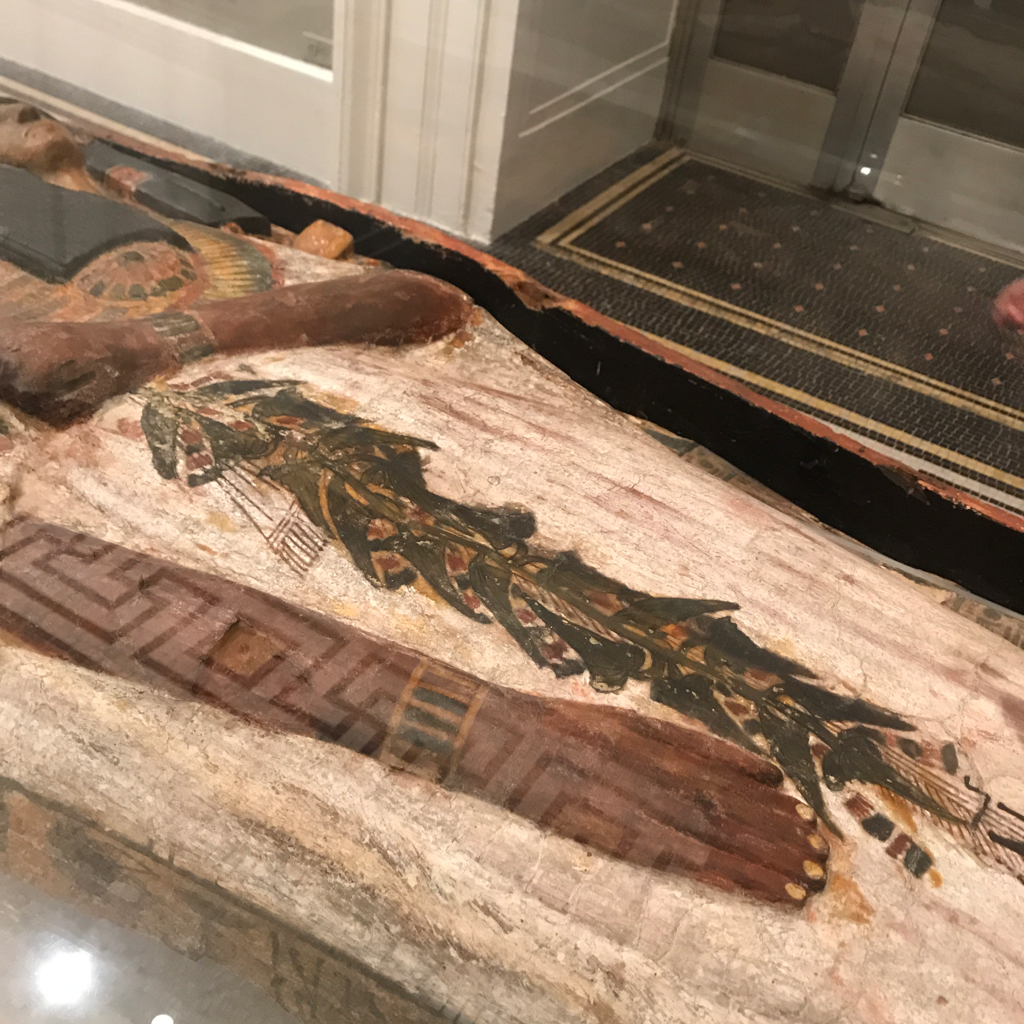
This likely represents a plant called bindweed. Flowers and vegetation were an important part of funerary iconography. Flowers especially were tied to concepts of rebirth because they appeared to die and come back to life.
Is this the same goddess I saw on Teti's coffin?
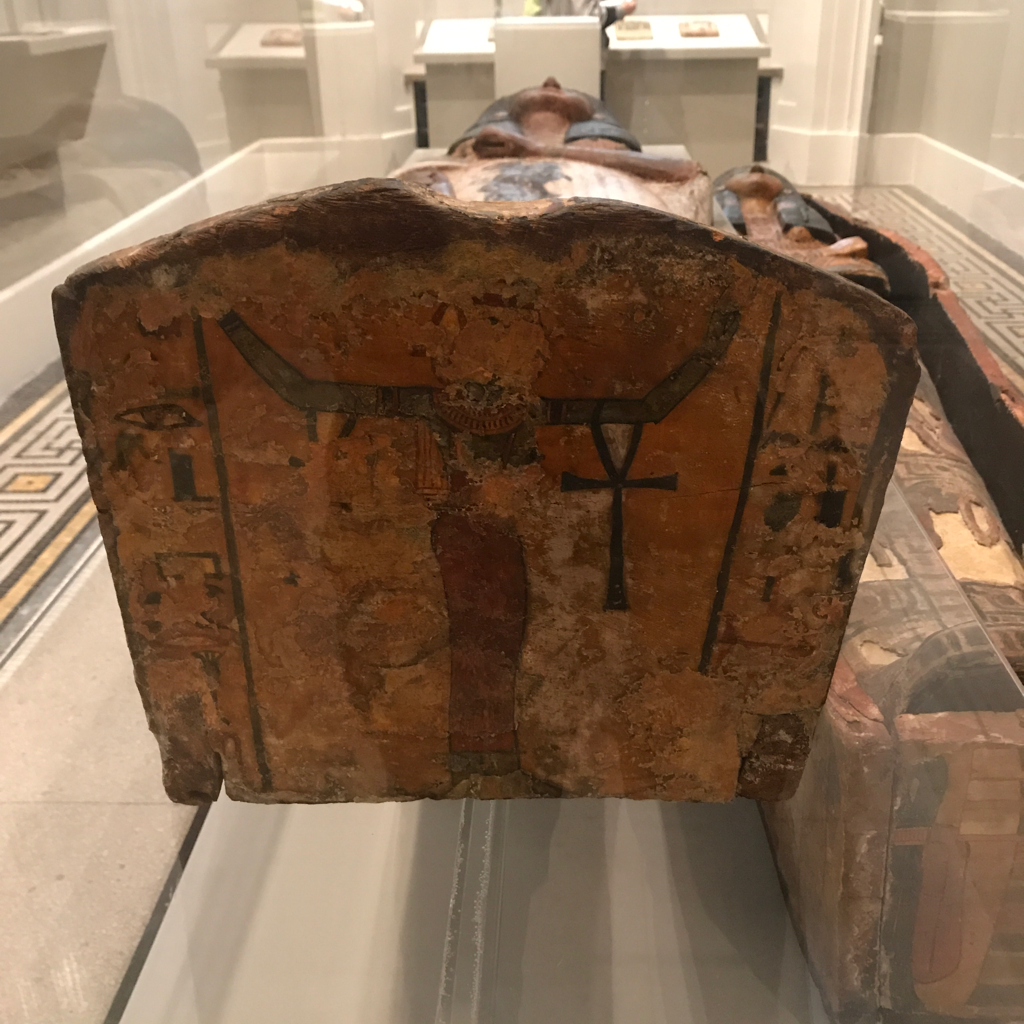
You're right! Isis and Nephthys are both very common on decorated coffins like this. Also, the date of this coffin is only a little later than that of Teti's.
Is this at all related to the use of beards on depictions of ancient Egyptian women?
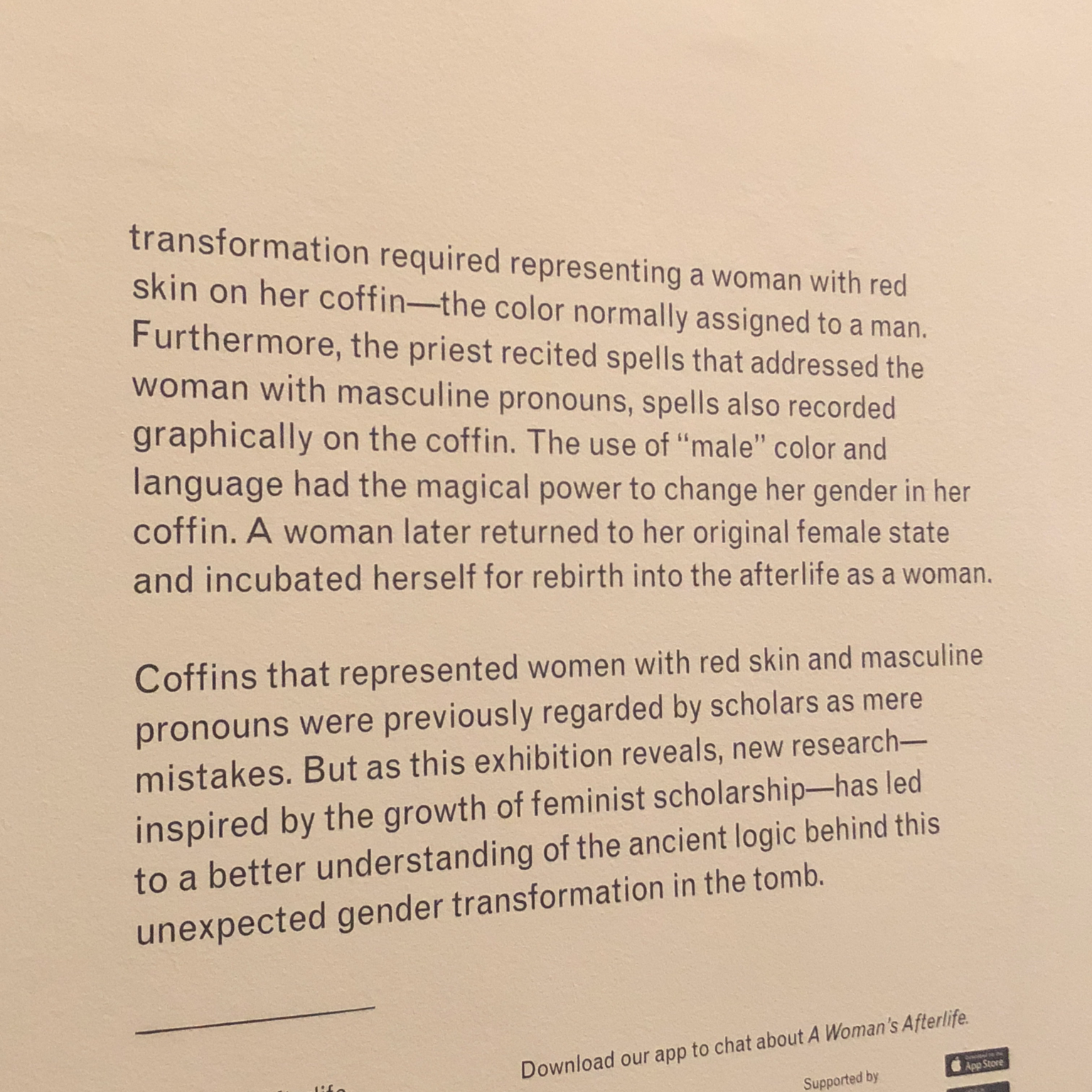
Interestingly, a few people have brought that up recently. The only ancient Egyptian women who would have been depicted with beards would have been female pharaohs like Hatshepsut.
In that case, the beard serves less as a mark of gender and more as kingly regalia. Though a woman, Hatshepsut was not a queen, she was a king, in the ancient Egyptian sense of the term.
Which god is this?

That is Thoth! He can be identified by his head, that of an ibis. He is often depicted on coffins holding a standard which is kind of like a sign.
Thoth was the god of all wisdom and knowledge which also meant he functioned as a judge and an advocate. His role in the journey to the afterlife was to assist the deceased especially during the Weighing of the Heart when it was determined if the deceased had been good enough to get into the afterlife.
It says that the red on the women’s coffin as well as the gender pronouns were dismissed as mistakes
How frequently would red/gender pronouns be noted on the sarcophaguses? Like all of the women’s, or a select few?
It wasn't all of them. The phenomenon addressed in A Woman's Afterlife was especially prevalent in one particular time period on coffins like the one belonging to Bensuipet, the one in the gallery.
Coffins followed different trends during different time periods and there were even different types produced at the same time based on regional differences and what the deceased could afford.
So it’s a practice -female to male to back again- that was only in one particular time/sect? Thank you!
You're welcome!It's not actually clear when, where, or how long this belief was held in general. We only know when it was addressed in coffin decoration.
Your exhibit on gender transformation is extremely interesting and well presented. Provides much needed context. Do you know of any parallels in their Books of the Dead?
Thank you! I will let the curators known! Books of the Dead would be a good place to look for a parallel! However, my understanding is that a big reason this research is only now coming to light is that gender transformation is only really referenced in coffins from the Ramesside Period.
A Woman's Afterlife presents research based on a few articles (including one published by our own Edward Bleiberg) that have come out in the last few years. It's a pretty new avenue so it will be some time before it is incorporated into standard museum displays especially because there are SO MANY stories to tell.
I will look for Bleiberg's arricle. Thank you so much for your insight. Your collection is over the top in quality and description, & you added another layer.
Thank you so much for your kind words and for visiting with us today! It was our pleasure to talk you through the collection!
Where were they getting the wood for these? Was the Nile that verdant back in the day?

The area surrounding the nile was certainly verdant, especially in the delta but woods were likely imported from further east, from places like Phonecia, modern day Lebanon.
Were all women buried in coffins with masculine pronouns and red skin? If not, how were women buried only as women expected to enter the afterlife?
No, not all women were buried this way (which is why scholars viewed this as an mistake for so long). So far, this seems to have been a trend during the 19th and 20th Dynasties.
These changes to the funerary objects were not required for a woman to transform into a man in the afterlife, but were thought to aid in the process.
Interesting stuff!
Dime más.
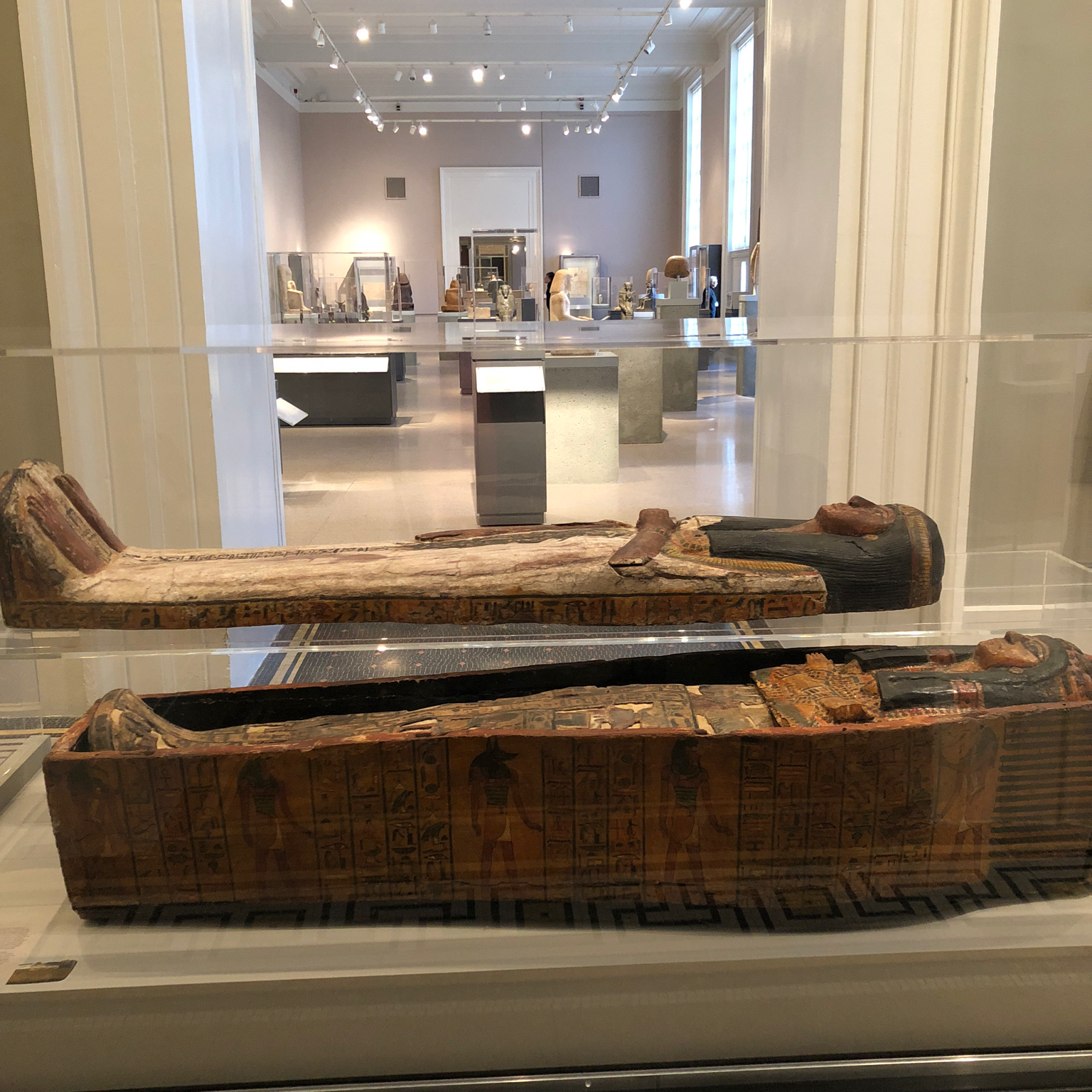
Este ataúd pertenece a una mujer llamada Weretwahset y fue reutilizado por Bensuipet. Puedes ver los colores diferentes de la parte exterior e interior. Rojo fue asociado con hombres y amarillo con mujeres.
Investigadores piensan que fue necesario que una mujer se transforma temporalmente en un hombre para ser renacido con éxito en la vida después de la muerte.
I also wanted to know if there were any coffins depicting women with yellow or gold skin on the outside and how they fit into the gender transformation theory outlined in the exhibition?
To answer your second question, there were definitely other outer coffins that showed women with gold or yellow skin rather than red. Part of the reason it took so long for researchers to develop this theory is because such red coffins were originally dismissed as anomalies or mistakes.
Is this view that women needed to be transformed into men in the afterlife consistent from the Old to New kingdom? What's the earliest evidence?
The key evidence that this hypothesis is based on, comes from the Ramesside period coffins like the one belonging to Weretwahset/Bensuipet seen in the exhibition.
The belief that the fetus was generated in the body of the father and transferred to the mother for gestation is an idea that certainly existed earlier that the Ramesside period, though I'm not sure of the earliest evidence.
The gender transformation that has been inferred from the coffins may have been long-standing or may just be one way that ancient Egyptians attempted to rectify their beliefs about both biology and the afterlife.
You may be interested in a 2010 article by Kathlyn Cooney, "Gender Transformation in Death: A Case Study of Coffins from Ramesside Period Egypt," which appeared in Near Eastern Archaeology.
Thanks! The modern interpretation that it was a "mistake" seems almost as interesting, in a way, as the Egyptian attempt to reconcile their scientific and religious views. It's an intriguing theory.
It's amazing that scholars believed for so long the meticulous Egyptians consistently made the same mistake over and over again! Taking a practical and open minded approach to the ancient world has proved very important. You're welcome!
I’d like to know if all women underwent such burial transformation rite irrespective of their social class.
Not all women were buried in this way, no. Burial was highly dependent on how wealthy the person being buried was, and also varied in different time periods. These red painted coffins were actually long seen as mistakes before scholars began to reexamine them, so they certainly weren't the only way women were buried.
That said, the idea that a woman would have to briefly turn into a man in the afterlife in order to be reborn applied to women regardless of whether or not they could afford a decorative coffin like the one you see in this exhibition.
That’s super interesting and a mind blower. Thanks so much!
¿Por qué esta tan rojo?
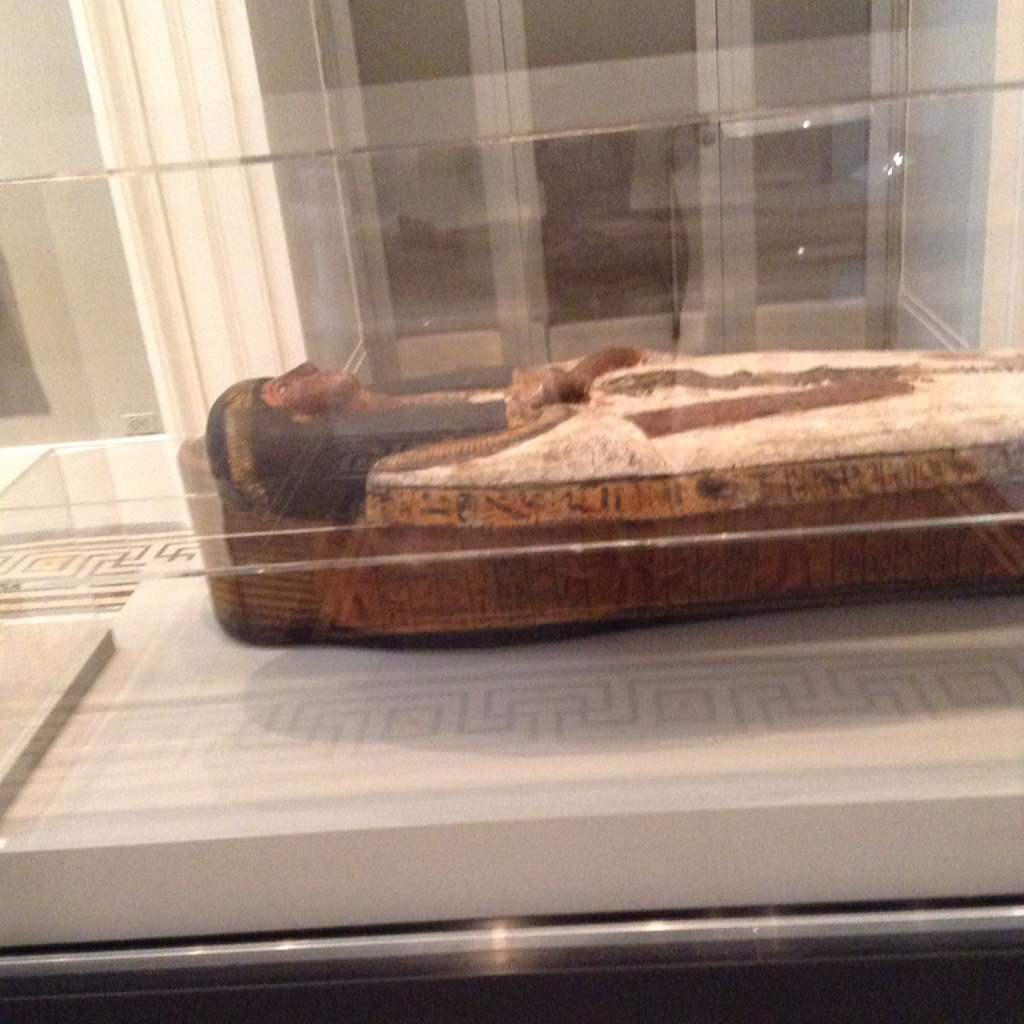
El color jugó un papel clave en la transformación de género en la tumba. La representación de esta mujer en su ataúd con piel roja, una característica que se considera masculina, fue una intervención mágica que transformó su género. La cara roja, las manos y los pies de este ataúd le otorgaron el poder masculino para crear un feto para su propio renacimiento.
Could you tell me more about the speeches priests would give during Ancient Egyptian gender transformation ceremonies? Or give me reading recommendations?
We assume that the texts on the coffin are a reflection of ceremonies that took place as part of the funerary process. It's likely that a priest would also refer to the deceased with male pronouns. The theory about gender transformation in the afterlife was extrapolated from parts of women's coffins (like the one in the exhibition) in which a god would refer to her with male pronouns.
The theory is corroborated by the fact that the woman would be shown with reddish-orange skin in some parts, a color that usually indicated a male.
We do know that the ancient Egyptians believed that a fetus was created in the man and placed into the woman for gestation. Based on that, it seems that the idea was a woman would temporarily transform into a man in order to conceive herself to be reborn in the afterlife.
You can read more about these theories in these two articles:
Cooney, Kathlyn M. "Gender Transformation in Death: A Case Study of Coffins from Ramesside Period Egypt." Near Eastern Archaeology 73 no. 4 (December 2010) 224-237.
And one by our curator, Edward Bleiberg, “The Coffin of Weretwahset/Bensuipet and “Scribal Errors” on Women’s Funerary Equipment,” Bulletin of the Egyptological Seminar 17 (2007) 29-46.
Thank you, I really appreciate it!
"Though rebirth in the tomb required gender transformation..." So the belief was that
women turn into men?

The theory is that a woman needed to temporarily transform into a man in order to conceive the fetus of her reborn self.
In ancient Egypt, it was believed that people were "reborn" into the afterlife and that coffins and various other containers acted as wombs. It was also believed that men (not women) created the fetus and transferred it to the woman during intercourse.
These beliefs presented a barrier to women wanting to be reborn into the afterlife since they were unable to be reborn by themselves. Through the use of spells and other religious rites, it was believed that after death a woman could temporarily transform to conceive her reborn self and then change back to a woman.
This exhibit explaining the way women turned into men mentions the red skin symbolic of being male. Is the pale skin on the mummy board because it wasn’t needed for the magical process?
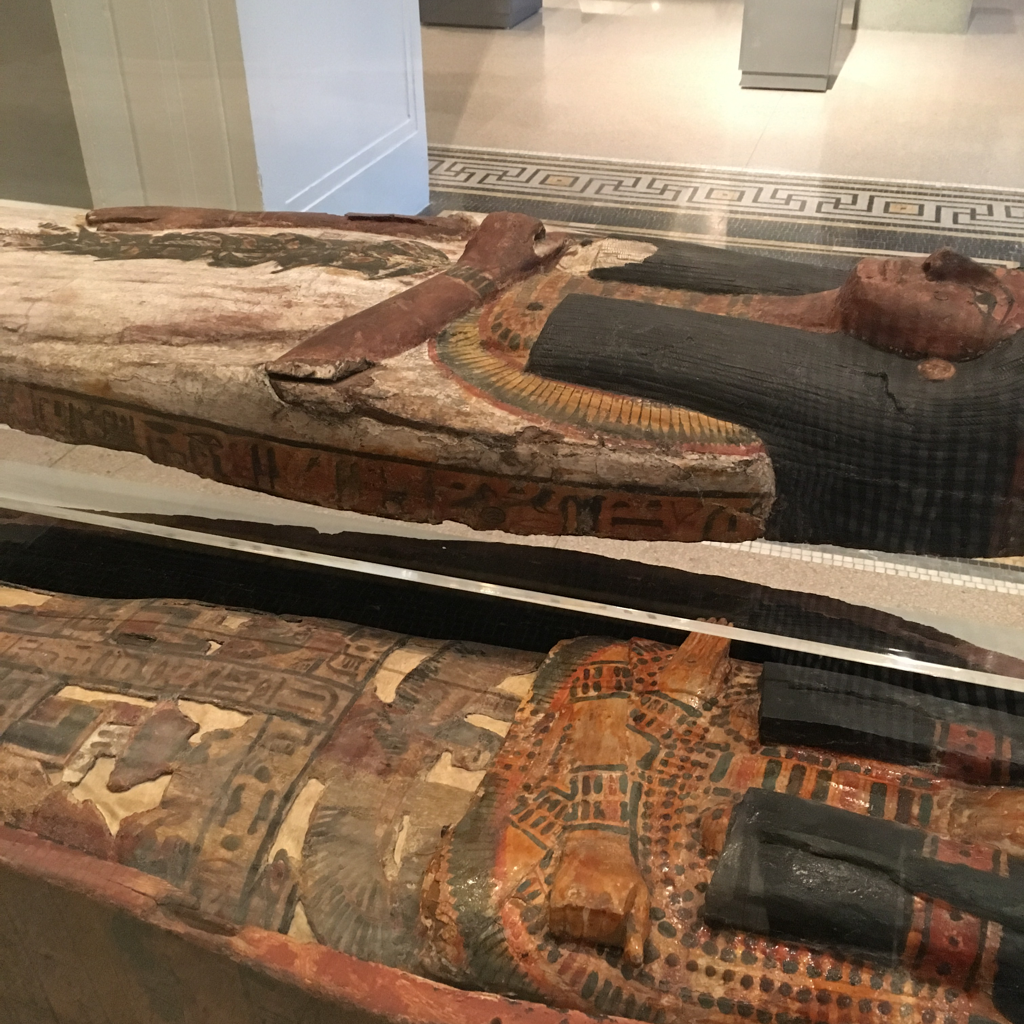
The mummy board inside of this coffin does show the deceased with lighter, female-colored skin to indicate that she has already been reborn and is ready to live out eternity as a woman.
Ah, that makes sense thank you.
Was the mummy board fastened to the linen or was the board laid on top of the mummy?

This mummy board was simply laid on top of the mummy.
There were indeed a variety of ways that mummies were decorated in ancient Egypt and some examples, like cartonnage, were formed around the mummy itself.
Interesting, thank you.
Really interested in this show, could you tell me more about it?

The show explores relatively recent research which seems to suggest that ancient Egyptian funerary religious practices required women to symbolically transform into men to be rebirthed successfully into the afterlife.
Egyptian medicine taught that fetus were created by men and transferred to women during intercourse to be gestated in the womb. When someone died, the concept of entering the afterlife was very similar to being reborn after death, with the coffin acting as a sort of womb.
For women, this was a bit of a problem because of the believed lack of ability to create a fetus. To overcome this, it was believed that a woman would temporarily transform into a man and some of the inscriptions on the coffin refer to her as such.
The exhibition shows the different ways that transformation manifests in various mummy and coffin decorations.
What colour were females' sarcophagi skin (before they were painted red in the woman's afterlife section)?
Whitish-yellow is the color associated with women. Yellow skin represented the skin of a goddess made from gold.
The Woman's Afterlife exhibition is mind blowing. What was the evidence that led to this theory?
The main piece of evidence that led to this theory is that on many coffins from one particular time period women are referred to with male pronouns in part of the inscription, suggesting that they are, effectively, men for part of the journey to the afterlife.
Earlier, this was dismissed as a mistake, but recently scholars have begun to think about the issue more critically. It didn't make sense for an identical mistake to appear so many times, especially given the ancient Egyptians' reputation for being meticulous.







































































































